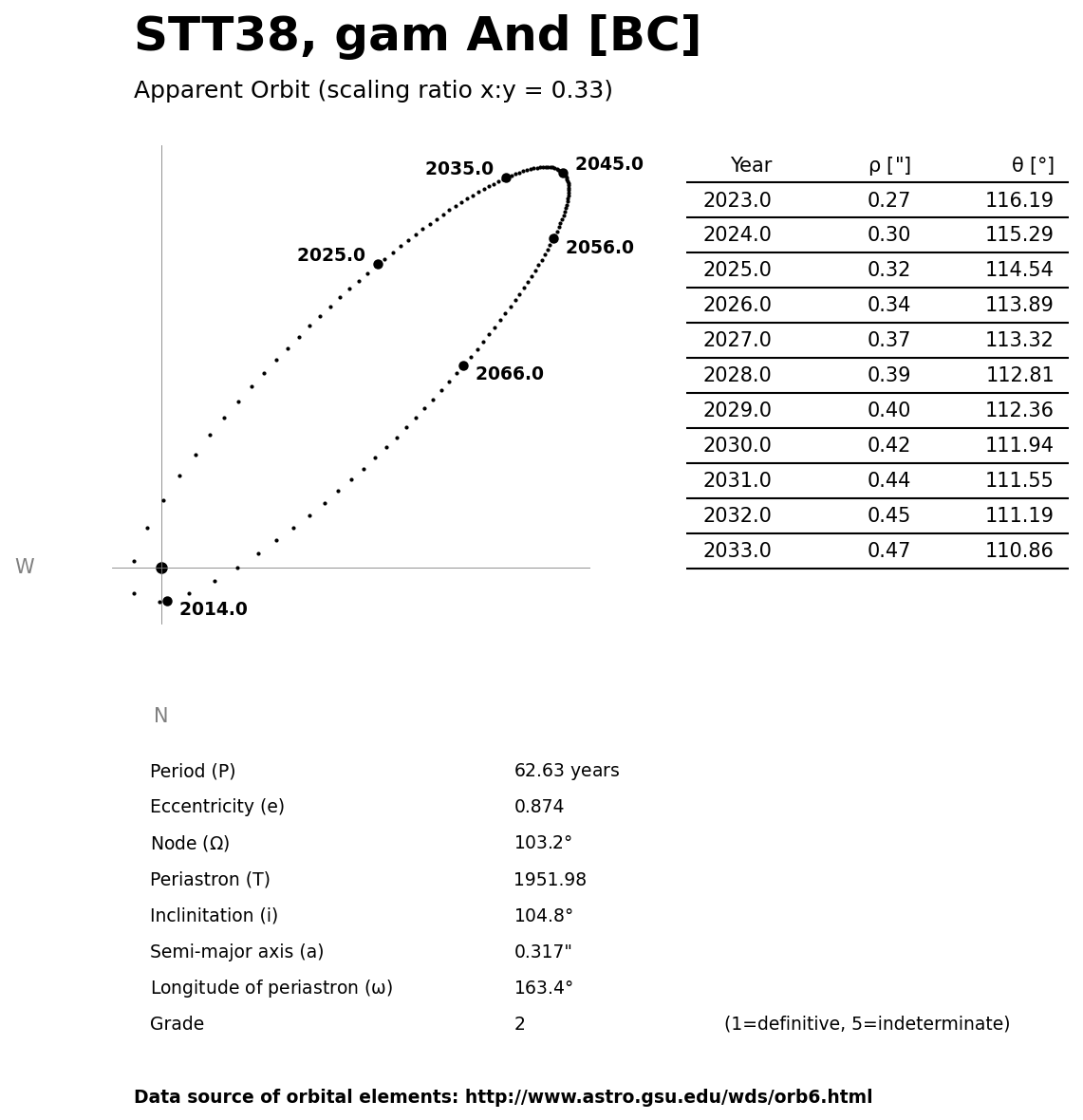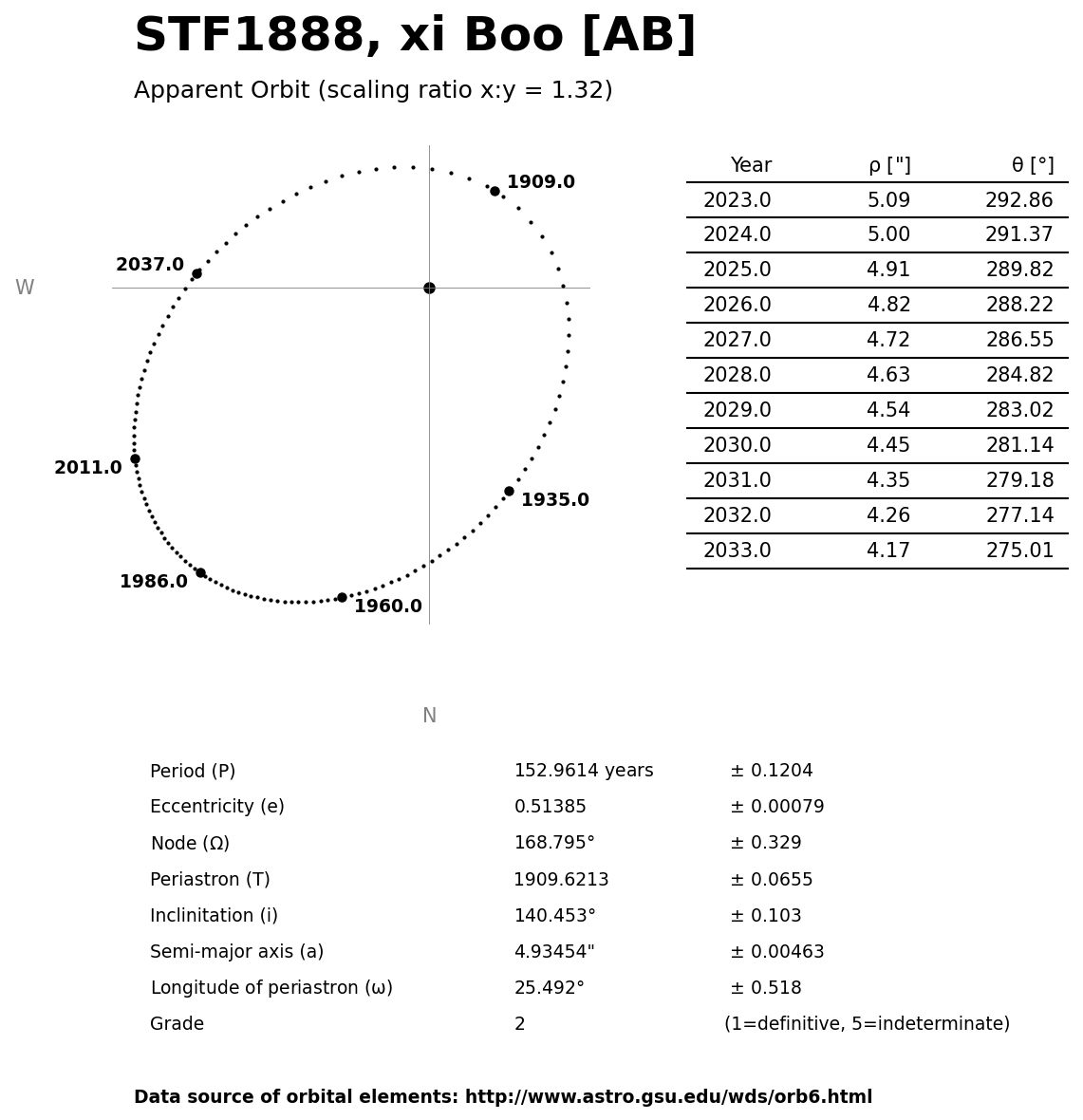|
m1 |
m2 |
ρ |
θ |
Year |
|
Coordinates (J2000.0) |
|
★★★
|
STTA254, WZ Cas |
|
AB |
7m.4 |
8m.3 |
57.8" |
89° |
2019 |
Cas |
00h01m15.85s / +60°21'19.00" |
|
|
|
|
AC |
7m.4 |
9m.6 |
155.4" |
324° |
2015 |
|
|
|
|
|
|
AD |
7m.4 |
10m.3 |
181.4" |
118° |
2016 |
|
|
Christopher Hay
Seeheim (Germany) |
6x24 |
AB: Clearly split. A definitely brighter than B. Under a NELM 5m5 sky both components appear weak in these mini-binoculars and no colour impression arises.;
WZ Cas is the variable designation of component A of STTA254. This semiregular carbon star has a mean brightness range of 6m8 to 7m7, and can reach extreme values of 6m3 at one end and 8m8 at the other. Perhaps it was too deep in a minimum at the time of observation to show colour with 1 inch of aperture? 15x45 binoculars revealed colour in this night, see observation below. |
|
Christopher Hay
Seeheim (Germany) |
15x45 |
AB: Wide split. A orange-red, B no particular colour. NELM 5m5, same night as 6x24 observation above. |
|
René Merting
Drachhausen (Germany) |
15x56 |
AB: einfach - beide Sterne zeigen sich komfortabel getrennt - Komponente A strahlt gelblich - Komponente B südöstlich wirkt dagegen grau und ist 1.5 bis 2 Größenklassen schwächer |
|
Robert Zebahl
Leipzig (Germany) |
16x70 |
AB: 2020-08-19: Intense orange & bluish. Very striking. |
|
René Merting
Drachhausen (Germany) |
16x70 |
AB: ein schöner Fernglas-Doppelstern - Komponente A im Westen präsentiert sich dunkelgelb (noch nicht orange), B im Osten ist eher weißlich |
|
René Merting
Drachhausen (Germany) |
18x70 |
AB: ein sehr auffälliger Doppelstern mit einem schönen Farbkontrast - A strahlt gelb, das kurz davor steht, ins Orange über zu gleiten - B wirkt im Kontrast aquamarin, so dezent wie eine typische PN-Farbe |
|
René Merting
Drachhausen (Germany) |
76mm (29x) |
AB: bei 29x ein wunderschönes Sternpaar mit einem auffälligen Farbkontrast, weit getrennt - Komponente B wirkt weißgrau bis weißblau gegen die gelborange strahlende A-Komponente - Helligkeitsunterschied eine Größenklasse |
|
René Merting
Drachhausen (Germany) |
76mm (29x) |
AB: Mondscheinbeobachtung - bei 29x ein weit getrenntes Pärchen, bei dem die A-Komponente nicht durch Strahlkraft, sondern durch seine auffallende Farbe besticht, ein sehr kräftiges Kupferorange - es gibt hellere Sterne im Umfeld, aber diese Komponente fällt besonders auf - die B-Komponente ist gut 1.5 mag schwächer und wirkt grau bis graublau |

|
Robert Zebahl
Leipzig (Germany) |
80mm (33x) |
AB: Nice double star. Brighter component appeared orange, the fainter more bluish. |
|
René Merting
Drachhausen (Germany) |
100mm (20x) |
AB: 20x reicht zwar schon für eine klare Trennung, aber Komponente B im Osten ist nur dumpf grau-blau und noch zu schwach für den schönen Farbkontrast, der sich bei 32x offenbart - Komponente A strahlt dann in einem satten Bernsteingelb, B im Osten gibt sich unterkühlt bläulich - Helligkeitsunterschied 1 bis 1.5 Größenklassen, schwierig abschätzbar wegen der Farben |
|
Sarah Gebauer
Germany |
100mm (49x) |
AB: sticht sofort ins Auge aufgrund des stärksten kupferroten Farbtons, den ich seit langem gesehen habe - der Begleiter strahlt bei 49-fach schon weit abgesetzt in einem graublauen, ganz kühlen Farbton |

|
Robert Zebahl
Leipzig (Germany) |
102mm (28x) |
AB: 2019-08-22: Splendid view. Primary component clearly orange, secondary blue. |
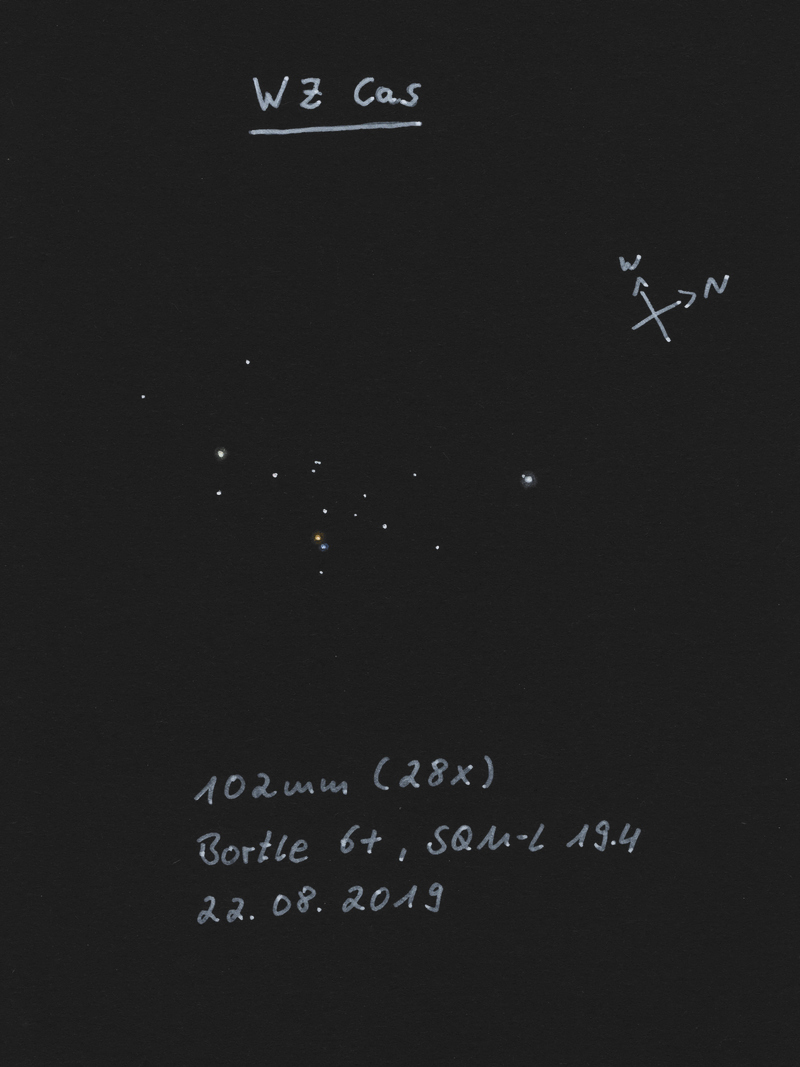
|
Jörg S. Schlimmer
Germany |
127mm (136x) |
Sehr schöner Farbkontrast |

|
Mark McCarthy
Fremont (California/USA) |
317mm (553x) |
AB: WZ Cas: Pretty, deep orange A and very wide half delta mag B, white. |
|
René Merting
Drachhausen (Germany) |
320mm (45x) |
AB: bei 45x ein weit getrenntes Pärchen mit wunderschönen Farbkontrast, Komponente A im Westen ist grell-orange und die gut 1.5 Magnituden schwächere Komponente B ist aquamarin-grau |
|
|
Robert Zebahl
Leipzig (Germany) |
102mm |
|

|
|
|
★
|
STF3053 |
|
AB |
6m.0 |
7m.2 |
15.2" |
70° |
2018 |
Cas |
00h02m36.08s / +66°05'56.30" |
Christopher Hay
Seeheim (Germany) |
15x45 |
Binoculars with internal stabilisation, handheld. Fine split with black in-between. A-component slightly orange. Colour of B-component hard to determine because of proximity to and glare of A-component, but does tend towards blue. |
|
Robert Zebahl
Leipzig (Germany) |
63mm (46x) |
Easy to split with noticeable difference in brightness. Brighter component appeared slightly orange, fainter one bluish. |
|
René Merting
Drachhausen (Germany) |
76mm (57x) |
bei 29x ein wunderschönes, gut getrenntes Sternpaar - Komponente B im Nordosten schimmert kühlweiß, die A-Komponente zart weißgelblich, dadurch ein dezenter Farbkontrast - bei 57x wird der Farbkontrast deutlicher, B ist etwas mehr als eine Magnitude schwächer und wirkt nun blau-grau, Komponente A strahlt deutlich hellgelb |

|
René Merting
Drachhausen (Germany) |
100mm (20x) |
bei 20x knapp getrennt, Komponente B östlich ist halb so hell wie A - während Komponente A weiß-gelblich strahlt, zeigt B sich weiß mit einem leichten Stich ins bläuliche |
|
Sarah Gebauer
Germany |
100mm (21x) |
schon in Aufsuchvergrößerung ganz leicht gelblich zu sehen und ist hauchfein getrennt - bei 49-fach dann nah, aber deutlich getrennt - die Hauptkomponente strahlt richtig schön goldgelb, der Begleiter zeigt ein schmutziges Gelb |
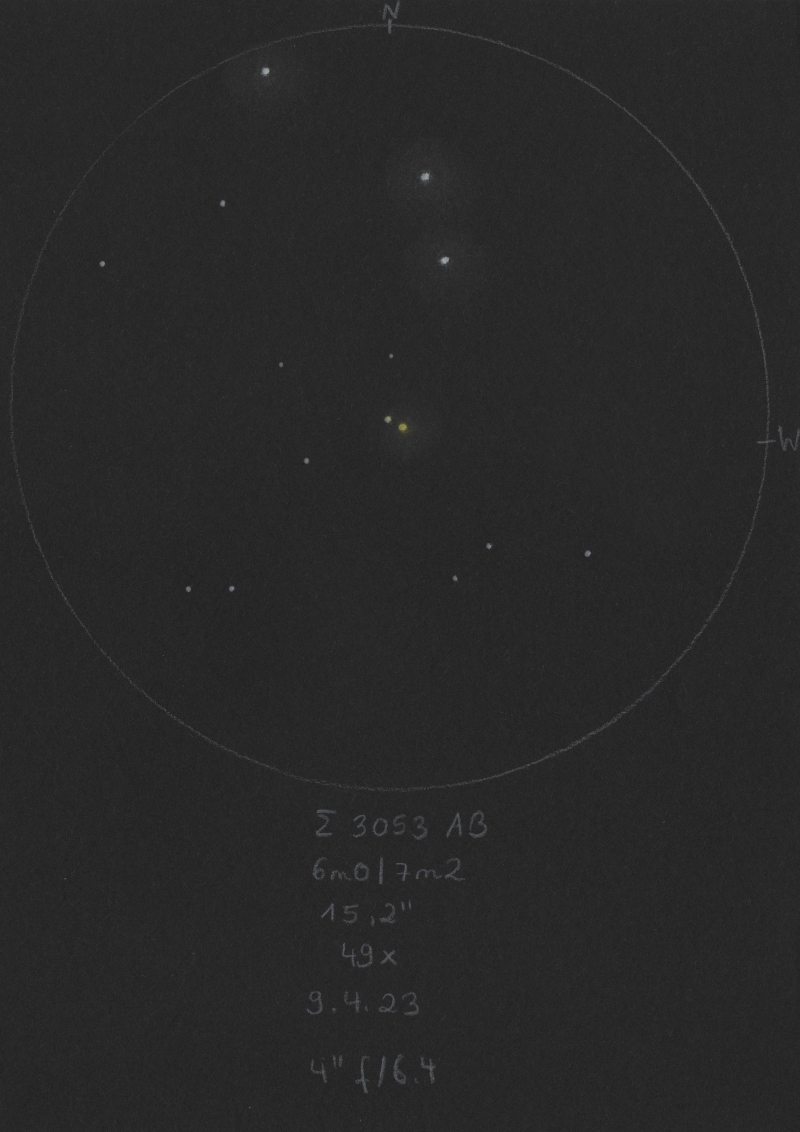
|
Sarah Gebauer
Germany |
100mm (49x) |
26.09.23: bei 49-fach ein ganz klassisch schönes, schmales Farbkontrastpaar - die westliche Komponente zeigt ein helles Orangegold, die östliche Grau mit einem Hauch hell leuchtendem Leinblütenblau |
|
Axel Tute
Küssaberg (Germany) |
200mm (77x) |
26.10.2006: Beautiful pair of stars in an interesting star field. Easy to separate in the C8 with the 26mm Plössl eyepiece. A is slightly orange, B is slightly greenish. Also very nice in the Comet Catcher (140/500mm Schmidt-Newton) at 50x in the 10mm Plössl. |
|
Mark McCarthy
Fremont (California/USA) |
317mm (553x) |
Pretty, orange and blue like Alberio. ~1.5 delta mag. |
|
|
|
|
H5 17, pi And, 29 And |
|
AB |
4m.4 |
7m.1 |
36.2" |
175° |
2019 |
And |
00h36m52.84s / +33°43'09.70" |
|
|
|
|
AC |
4m.4 |
13m.0 |
55.2" |
356° |
2016 |
|
|
Robert Zebahl
Leipzig (Germany) |
8x44 |
AB: 2020-11-25: Not separable. The faint companion was probably outshone by the bright primary component. |
|
Robert Zebahl
Leipzig (Germany) |
102mm (28x) |
AB: 2020-11-02: Quite large separation and large difference in brightness. A: white-yellowish, B: slightly bluish. |
|
Uwe Pilz
Leipzig (Germany) |
105mm (88x) |
AB: (HV 17) blauweiß und violett-grau |

|
Sarah Gebauer
Germany |
254mm (96x) |
AB: bei 96-fach weit getrennt mit einer schön hellen, reinweißen Komponente und einer leicht schwächeren, grauen Begleitkomponente – bei 49-fach zeigt sich die Hauptkomponente leicht weißgelblich, der Begleiter grau mit einem Hauch von Blau |
|
René Merting
Drachhausen (Germany) |
320mm (45x) |
AB: bei 45x ist Komponente B weit abgesetzt südlich von der weiß glänzenden A-Komponente zu erkennen - B ist mindestens 2.3 bis 3.0 Magnituden schwächer |
|
|
|
★★
|
eta Cas, 24 Cas |
STF60 |
AB |
3m.5 |
7m.4 |
13.6" |
326° |
2020 |
Cas |
00h49m06.29s / +57°48'54.70" |
|
|
|
STF60 |
AC |
3m.5 |
11m.4 |
225.0" |
260° |
2000 |
|
|
|
|
|
STF60 |
AD |
3m.5 |
12m.8 |
189.4" |
354° |
2011 |
|
|
|
|
|
STF60 |
AE |
3m.5 |
10m.2 |
75.6" |
126° |
2015 |
|
|
|
|
|
STF60 |
AF |
3m.5 |
11m.5 |
378.3" |
276° |
2000 |
|
|
|
|
|
STF60 |
AG |
3m.5 |
9m.5 |
419.7" |
259° |
2012 |
|
|
|
|
|
STF60 |
AH |
3m.5 |
8m.4 |
701.1" |
355° |
2012 |
|
|
|
|
|
SMR2 |
AI |
3m.5 |
11m.6 |
90.3" |
73° |
2012 |
|
|
|
|
|
SMR2 |
AJ |
3m.5 |
12m.3 |
237.1" |
262° |
2012 |
|
|
|
|
Robert Zebahl
Leipzig (Germany) |
70mm (57x) |
AB: Easy to split with big difference in brightness. Fainter component appeared deep orange to slightly red colored, brighter component tends to be more slightly yellowish. |
|
René Merting
Drachhausen (Germany) |
76mm (29x) |
AB: Mondscheinbeobachtung - bei 29x zeigt sich Komponente A in einem schönen hellen und doch intensiven Gelb - Komponente B ist knapp getrennt nordwestlich von A erkennbar, das wirkt aber noch nicht richtig souverän - riesiger, nicht abschätzbarer Helligkeitsunterschied - B wirkt kupferbraun, manchmal auch nur grau - bei 57x sind beide Sterne etwas mehr als knapp getrennt zu erkennen und das kupferbraun bei B setzt sich durch |

|
René Merting
Drachhausen (Germany) |
100mm (32x) |
AB: bei 32x ist Komponente A so hell, dass B trotz des augenscheinlich großen Abstandes von 13,4" nur knapp getrennt zu sehen ist - Komponente A ist gleißend hell-gelb, B dürfte mindestens 3 Größenklassen schwächer sein und wirkt dadurch dumpfer |
|
Sarah Gebauer
Germany |
100mm (49x) |
AB: bei 49-fach schmal und schön getrennt - so ein starker, warmgoldener Farbton, der richtig leuchtkräftig ist, ein echter Blickfang - der Begleiter zeigt eine ähnliche Farbe, aber doch matter und bräunlicher |

|
Uwe Pilz
Leipzig (Germany) |
105mm (53x) |
AB: leicht |
|
Uwe Pilz
Leipzig (Germany) |
105mm (288x) |
kein Sternentstehungsgebiet! |

|
Sarah Gebauer
Germany |
150mm (54x) |
AB: bei 54x erst nur einen Stern gesehen, doch da, ganz schwach darunter doch die wesentlich schwächere, zweite Komponente entdeckt |

|
Robert Zebahl
Leipzig (Germany) |
152mm (30x) |
AB: 2021-09-11: Light yellow & red-brownish. |
|
Winfried Kräling
Marburg (Germany) |
152mm (175x) |
|

|
Axel Tute
Küssaberg (Germany) |
200mm (77x) |
AB: 30.10.2006: Easy to separate in the C8 with the 26mm Plössl eyepiece. A is bluish. B is reddish. PA estimated 300°. |
|
Mark McCarthy
Fremont (California/USA) |
317mm (553x) |
AB: Nice yellow pair. A is a red tainted yellow, B is cleaner. |
|
René Merting
Drachhausen (Germany) |
320mm (72x) |
AB: bei 72x ein echt fetter Farbkontrast, Komponente A ist gleißend hell und zitronengelb, B zeigt sich knallig orange - beide Sterne sind gut getrennt voneinander zu beobachten - sehenswert |
|
|
|
|
STFA3, 37 Cet |
|
AB |
5m.2 |
7m.8 |
47.1" |
331° |
2018 |
Cet |
01h14m24.04s / -07°55'22.20" |
René Merting
Drachhausen (Germany) |
100mm (32x) |
bei 32x ein weit auseinander stehender Doppelstern mit einem schönen Farbkontrast, Komponente A im SO ist weisgelblich, die gut 2 Magnituden schwächere Komponente B ist eher schmutzig grauorange |
|
Mark McCarthy
Fremont (California/USA) |
317mm (553x) |
37 Cet: Both orange, B 3 delta mag, so more intense orange. Wide separation PA to the north. |
|
|
|
★★
|
1 Ari, STF174 |
|
|
6m.3 |
7m.2 |
2.9" |
164° |
2018 |
Ari |
01h50m08.60s / +22°16'29.50" |
Robert Zebahl
Leipzig (Germany) |
63mm (46x) |
Clearly split, but tight with noticeable difference in brightness. |
|
Robert Zebahl
Leipzig (Germany) |
70mm (80x) |
At 67x pretty tight pair, but separated with a clear difference in brightness. The primary component appeared in a hint of orange. At 80x easy to separate. |
|
Christopher Hay
Seeheim (Germany) |
76mm (83x) |
1 Arietis is clearly orange (not split) in 12x42 finder. In 3-inch at 83x fine split, primary fiery orange. At 100x split becomes more obvious, at 125x easy, but at expense of loss of colour. |
|
Sarah Gebauer
Germany |
100mm (80x) |
25.09.23: mit 80-fach blickweise getrennt, ein extrem enges Pärchen - der Farbeindruck ist sehr strohgelb mit einem strahlend hellen, weiß getupften Sternzentrum - bei 128-fach ist die Trennung einfacher zu halten, durch die Farbe und den sehr geringen Abstand machen dieses Paar zu einem besonders reizvollen Farbdoppelstern |

|
Stefan Loibl
Rosenheim (Germany) |
102mm (102x) |
slight color difference, A orange, B blueish |
|
Sarah Gebauer
Germany |
150mm (27x) |
im Dezember 2019 nicht getrennt |
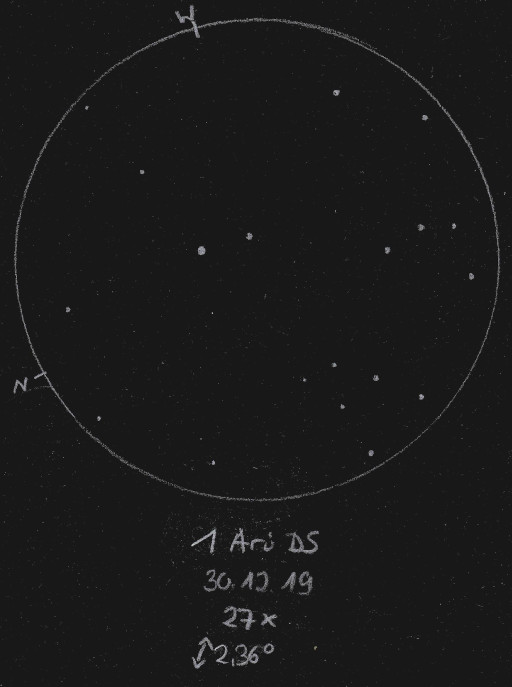
|
Axel Tute
Küssaberg (Germany) |
200mm (77x) |
26.10.2005: STF 174 could be separated with the C8 already with the 26mm Plössl (77x). Better with the 12mm RKE (167x). |
|
Robert Zebahl
Leipzig (Germany) |
200mm (100x) |
Conditions in the target region: SQM-L 20.8
Nice double star with big difference in brightness. |
|
Mark McCarthy
Fremont (California/USA) |
203mm (533x) |
1 Ari. ! Very beautiful yellow-orange A and robin's egg blue B, 3", one delta mag. probably one of the best color pairs |
|
Mark McCarthy
Fremont (California/USA) |
317mm (553x) |
Pretty orange and blue pair, ~2 delta mag, ~2". |
|
Karsten Kopp
Köln (Germany) |
600mm (180x) |
Gut zu trennender Doppelstern mit schon auffälligem Helligkeitsunterschied. Der hellere leuchtet gelblich und der schwächere geht ins bläuliche. Schöner Doppelstern. |
|
|
|
★★★
|
gamma And, 57 And, Alamak |
STF205 |
A-BC |
2m.3 |
5m.0 |
9.5" |
63° |
2021 |
And |
02h03m53.92s / +42°19'47.50" |
|
|
|
BAR22 |
AD |
2m.3 |
15m.0 |
27.9" |
245° |
1898 |
|
|
|
|
|
STT38 |
BC |
5m.3 |
6m.5 |
0.3" |
120° |
2021 |
|
|
|
|
Robert Zebahl
Leipzig (Germany) |
56mm (40x) |
A-BC: 2024-10-31: Nicely separated with a clear difference in brightness. Component A appeared in a bright yellow-orange. |
|
Robert Zebahl
Leipzig (Germany) |
63mm (42x) |
A-BC: Easy to split with quite large difference in brightness. |
|
Christopher Hay
Seeheim (Germany) |
71mm (32x) |
Fine split. A is mandarine orange. BC has trouble displaying its colour due to the overpowering light of A, but in good moments is clearly blue.
A-BC is a physical double at a distance to us of 393 light years.
BC is also physical, with a relatively short period of 63 years for C to circle B and a very tight periastron. Unobservable in 2013 at periastron with 0.1". Since then the angular separation has been widening rapidly and will reach 0.4" in 2029. B-C will then become observable in large amateur telescopes for three decades, after which C will fall quickly back to B. |
|
René Merting
Drachhausen (Germany) |
76mm (29x) |
A-BC: bei 29x äußerst knapp getrennt - Komponente A strahlt buttergelb, BC schmiegt sich im Nordosten an |
|
Uwe Pilz
Leipzig (Germany) |
105mm (52x) |
A-BC: einfach |
|
Uwe Pilz
Leipzig (Germany) |
120mm (128x) |
A-BC |

|
Robert Zebahl
Leipzig (Germany) |
152mm (100x) |
A-BC: Very easy. A: orange, BC: rather white. |
|
Christopher Hay
Seeheim (Germany) |
180mm (110x) |
A very strong pair in 0.6° FOV with powerful colour contrast, A yellow, BC ice blue. |
|
Sarah Gebauer
Germany |
254mm (96x) |
A-BC: in Dänemark als Startstern für die Suche nach der Galaxie NGC 891 gewählt und ohne Vorwissen spontan als sehr schönen Doppelstern erkannt: die Hauptkomponente strahlt richtig schön goldgelb, der Begleiter nordöstlich davon ist richtiggehend reinweiß und klein, wirklich toll! |
|
René Merting
Drachhausen (Germany) |
320mm (45x) |
A-BC: bei 45x ein knapp getrenntes Pärchen - Komponente A knallgelb mit einem Anhängsel nordöstlich - Komponente BC strahlt 3 Größenklassen schwächer - bei 144x wirkt BC grün-weiß, bei 45x war der Eindruck noch leicht gelblich |
|
Mark McCarthy
Fremont (California/USA) |
508mm (667x) |
BC: Component of STF 205, of which A is a brilliant orange and BC bright blue. In BC I can only see elongation through the speckle at 667x and 1067x. Short 62.63 year period which will get "easier" to about 0.2" by 2045 |
|
Mark McCarthy
Fremont (California/USA) |
508mm (1067x) |
BC: I spent a good long while on this one, and tried hard to nail down the position angle. At 1067x, both with and without an apodising mask, but both times with a #80A light blue filter, which did seem to calm the diffraction a little, I had a clear view of the elongation with a strong sense of the weaker end being to the East or to the ESE. I also tried a 78% central obstruction mask, and while the diffraction became a grid, and the disks much smaller, I could clearly see the same elongation and weaker end, though at a much smaller scale. To my delight the current orbital solution puts the PA at 120.6-degrees, 0.179" separation, so I think I have detected it. I can't wait until 2033 when this becomes an easy pair! |
|
|
Winfried Kräling
Marburg (Germany) |
127mm |
A-BC: Aufnahme vom 11.09.2020 am 127/1200mm Refraktor mit Barlowlinse (~2.5x)
Weit getrennt, Komponente A: goldgelb bis orange, Komponente BC: weißlich blau |
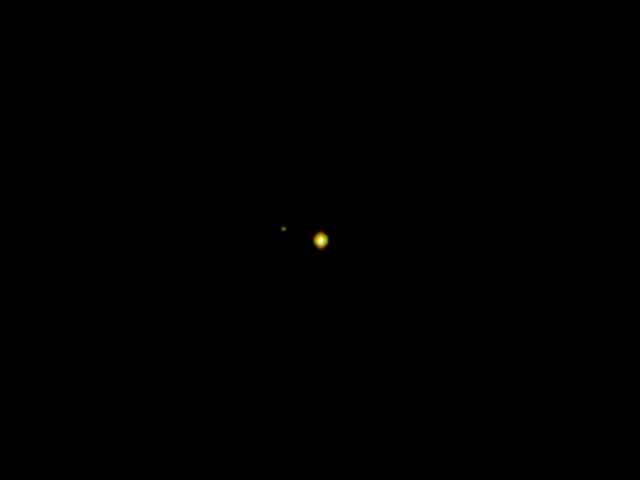
|
Werner E. Celnik
Rheinberg (Germany) |
150mm |
A-BC |

|
|
|
★★
|
iota Cas, STF262 & CHR6 |
CHR6 |
Aa-Ab |
4m.6 |
8m.5 |
0.6" |
42° |
2010 |
Cas |
02h29m03.96s / +67°24'08.70" |
|
|
|
STF262 |
AB |
4m.6 |
6m.9 |
2.9" |
230° |
2017 |
|
|
|
|
|
STF262 |
AC |
4m.6 |
9m.1 |
6.7" |
117° |
2015 |
|
|
|
|
|
STF262 |
AD |
4m.6 |
8m.5 |
210.9" |
60° |
2016 |
|
|
|
|
Robert Zebahl
Leipzig (Germany) |
55mm (27x) |
Only the D component was well visible. The components B & C were not visible even at magnifications up to 167x. The sky was clearly brightened (Bortle 7). |
|
Robert Zebahl
Leipzig (Germany) |
70mm (120x) |
Components A, B and C pretty close together, D far apart. Component B appeared slightly elongated on the first diffraction ring of the primary component. Rewarding! |
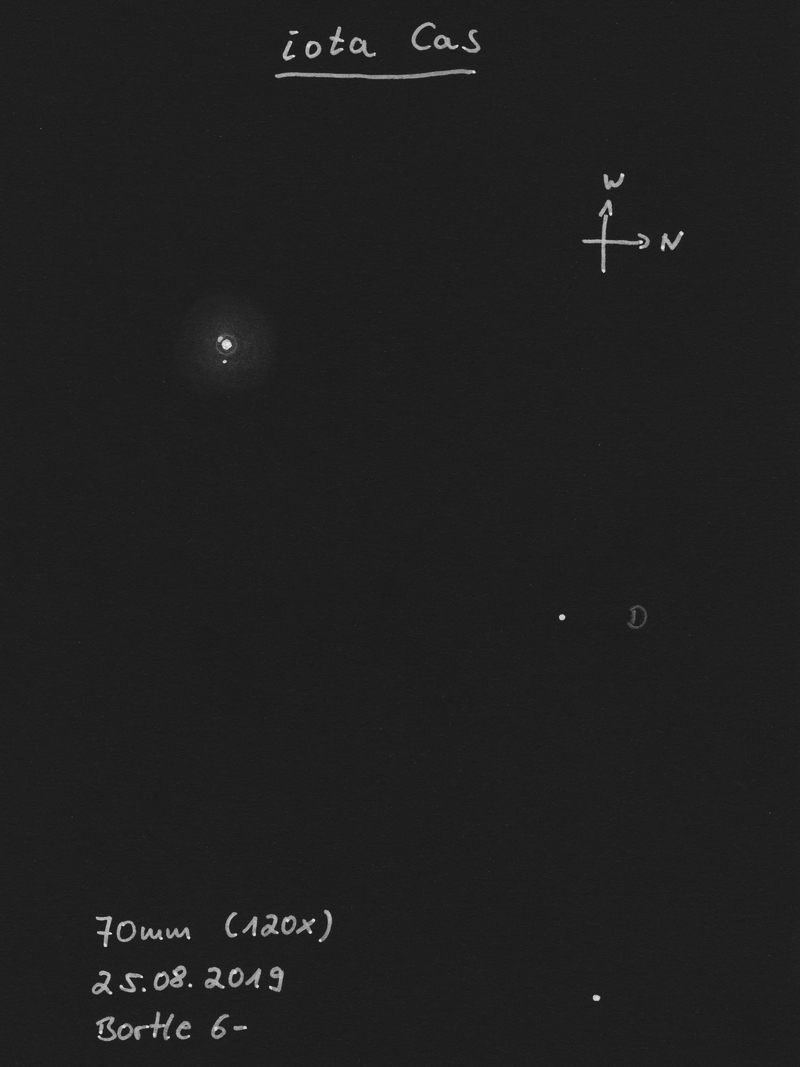
|
René Merting
Drachhausen (Germany) |
76mm (127x) |
AB: bei 95x zeigt sich Komponente B im SW im Beugungsring von A - bei 127x wird die Trennung dann eindeutiger, ein schönes Bild, B steht mitten im Beugungsring, der nur einen Bogen von 180° beschreibt, so sieht B aus wie ein Komet, der um A kreist
AC: bei 57x knapp getrennt, C zeigt sich östlich von A und ist ganz schwach
AD: leider nicht darauf geachtet |
|
Sarah Gebauer
Germany |
100mm (80x) |
bei 49-fach schon warmgelb als ein Stern zu sehen, bei 80-fach taucht dann östlich eine super schwache, sehr dicht stehende Komponente auf - südlich schmiegt sich noch eine sichelförmige Ausbuchtung an, die bei 136-fach zu einem haarfein getrennten Sternchen wird |

|
René Merting
Drachhausen (Germany) |
100mm (142x) |
AB: bei 142x zeigt sich Komponente B im SW mit gut einem Drittel das Abstandes AC, Helligkeitsunterschied 1.5 bis 2 Größenklassen
AC: bei 64x getrennt, schöner Farbkontrast, Komponente A ist weiß mit einem Stich ins Gelbe, C leicht bräunlich
AD: bei 32x extrem weiter Abstand zwischen A und D, Helligkeitsunterschied mehr als 2 Größenklassen (laut Stelle Doppie sogar 3.85 mag) |
|
Uwe Pilz
Leipzig (Germany) |
105mm (200x) |
Dreifachstern lohnend |

|
Sarah Gebauer
Germany |
150mm (160x) |
bei 160x sind die Komponenten AC getrennt, B leider nicht, die schwache Komponente C versinkt fast im Strahlen der hellen Komponente A, ein sehr reizvoller Anblick! Von Komponente D wusste ich während der Beobachtung noch nichts, sie taucht unter den Feldsternen der Zeichnung auch auf |

|
Robert Zebahl
Leipzig (Germany) |
152mm (129x) |
Component D easy to see even at lowest magnification. Component C is also easily visible at 49x. At 69x the component B is indicated, at 100x clearly visible. C appears slightly grey-bluish and obviously fainter than B. Grand sight at 129x! |
|
Mark McCarthy
Fremont (California/USA) |
508mm (1067x) |
CHR6 (Aa-Ab): This is a component of Iota Cas, STF 262 (which is a really pretty triple). CHR 6 at 1067x and seeing through the speckle image, I get elongation with a suspected blunter end which I assume is the B side, PA to the north [it's actually to the south -- my general orientation is correct but mis-interpret the brighter end]. Physical with 47 year period, currently at periastron and will tighten to 0.2" by 2036 |
|
|
|
★★★
|
STF93, alpha UMi, 1 UMi, Polaris |
|
AB |
2m.0 |
9m.1 |
18.4" |
236° |
2016 |
UMi |
02h31m49.09s / +89°15'50.70" |
|
|
|
|
AC |
2m.0 |
13m.8 |
39.0" |
103° |
2016 |
|
|
|
|
|
|
AD |
2m.0 |
14m.3 |
83.2" |
194° |
2016 |
|
|
Christopher Hay
Seeheim (Germany) |
71mm (32x) |
B well separated, a fine blue pinprick next to luminous yellow A.
Alpha UMi, Polaris, is a physical double at a distance to us of 433 light years. |
|
René Merting
Drachhausen (Germany) |
76mm (29x) |
AB: Mondscheinnacht - bei 29x zeigt sich ein schönes Sternpaar, knapp getrennt - B ist sehr schwach, aber noch gut zu erkennen - Helligkeitsunterschied enorm - das Paar ist dennoch sehr ansehnlich, zumal A in einem schönem Gelb strahlt |
|
Christopher Hay
Seeheim (Germany) |
76mm (40x) |
B well set off from A. Glare from A is an issue, consciously trying to ignore A helps. Very slight yellowish tone of A. Seeing the difficulty makes it clear why attempts in other nights to split the pair with 25x80 binoculars failed. |
|
René Merting
Drachhausen (Germany) |
100mm (32x) |
AB: bei 32x knallt die Hauptkomponente A schön hellgelb rein, Komponente B ist als feiner zarter Lichtpunkt knapp daneben erkennbar - Größenklassenunterschied nicht abschätzbar, auf jeden Fall riesig |
|
Sarah Gebauer
Germany |
100mm (49x) |
AB: bei 49-fach sauber getrennt, A ist sehr hell, warmweiß und erzeugt einen feinen Spike im Amiciprisma, B steht ausreichend weit entfernt, durch die Helligkeit von A aber doch wieder nicht ganz so weit abgesetzt und scheint mausgrau - bei 80-fach gewinnt A einen wesentlich gelblicheren Farbton und wirkt nun mittig weiß und ansonsten goldorange |

|
Christopher Hay
Seeheim (Germany) |
180mm (113x) |
B widely separated from A. A has definite yellowish hue. B luminous aquamarine blue, very attractive. |
|
René Merting
Drachhausen (Germany) |
320mm (45x) |
AB: bei 45x ist B sehr knapp getrennt von A erkennbar - Komponente A strahlt auf den ersten Blick weiß, bei genauerem Hinsehen mischt sich ein zartes Gelb unter |
|
|
|
★★★
|
AG304, 15 Tri |
|
|
5m.6 |
6m.8 |
142.4" |
16° |
2013 |
Tri |
02h35m46.82s / +34°41'15.20" |
Christopher Hay
Seeheim (Germany) |
7x50 |
Well split. Main star yellow-orange, secondary an ice-blue pinprick. With overall brightness of 5m1 just visible to naked eye under my suburban sky. Interesting star field with a line of 5 stars pointing S-SW away from 15 Tri and a further striking star chain to the west. Placing Gamma-Delta-7 Tri within 7.5° FOV makes a very attractive overall field. Mira variable R Tri just ½ degree to the S-SE was around maximum at time of observation and presented a much paler orange than 15 Tri A. Charming colour contrast ensemble with the two components of the double plus the variable. |
|
René Merting
Drachhausen (Germany) |
18x70 |
ein extrem komfortabel getrenntes Sternpaar - Komponente A im Süden strahlt weißgelb, B ist 1.5 Größenklassen schwächer und wirkt kupfergrau - interessant: parallel zu den beiden Sternen stehen westlich zwei deutlich schwächere Sterne in gleichem Abstand und Positionswinkel wie die Komponenten von 15 Tri - alle 4 Sterne bilden ein Parallelogramm |
|
Christopher Hay
Seeheim (Germany) |
80mm (30x) |
A beautiful, wide pair. Main star orangish yellow, secondary ice-blue. Attractive star field in 2.7° FOV: several similarly-separated pairs to the north and east, and two striking star chains to the south and west. |
|
Sarah Gebauer
Germany |
100mm (21x) |
ein wirklich schönes, farbiges Pärchen, das schon bei geringster Vergrößerung deutlich getrennt und in einem Eisblau und leichtem Orange strahlt, zudem bildet es mit der markanten Sternkette östlich davon, die im Refraktor mit Amiciprisma ein auf dem Kopf stehendes T bildet, ein tolles Gesamtbild |
|
Sarah Gebauer
Germany |
100mm (21x) |
25.09.23: mit 21-fach erinnert dieser Doppelstern fast an das Farbkontrastdoppel Delta Cephei, er ist weit getrennt und zeigt eine ganz klassisch warm gelbgoldene A-Komponente und in sehr weitem Abstand eine metallisch azurblau leuchtende B-Komponente |
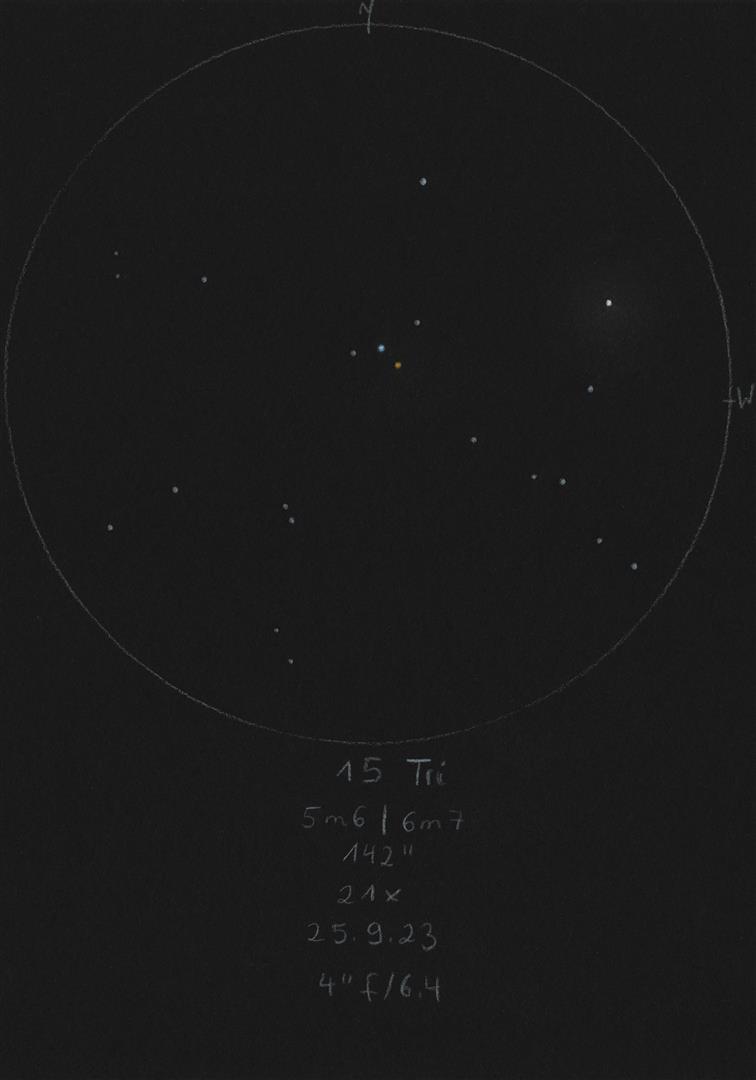
|
René Merting
Drachhausen (Germany) |
320mm (45x) |
bei 45x weit auseinanderstehend, aber dennoch schön anzusehen - A ist rapsgelb, B im Norden wirkt unterkühlt weiß bis graublau |
|
|
|
★★
|
30 Ari |
STFA5 |
AB |
6m.5 |
7m.0 |
37.9" |
275° |
2019 |
Ari |
02h37m00.52s / +24°38'50.00" |
|
|
|
RAO8 |
BC |
7m.0 |
11m.0 |
0.6" |
282° |
2018 |
|
|
Robert Zebahl
Leipzig (Germany) |
8x44 |
AB: 2020-11-25: Easy to split at still quite small separation and visible difference in brightness. The primary component appeared white-yellowish, the companion darker. |
|
Robert Zebahl
Leipzig (Germany) |
12x42 |
AB: 2022-10-19: Easy to split at moderate separation and small difference in brightness. Well visible color difference, although it is difficult to assign the color to the components: white-bluish & yellow-orange. |
|
Robert Zebahl
Leipzig (Germany) |
70mm (22x) |
AB: At 22x widely separated, striking with a rather small difference in brightness. A seemed a bit warmer in color compared to B with a hint of orange. At 44x, both seemed slightly orange with very little difference in color. |
|
Sarah Gebauer
Germany |
100mm (21x) |
AB: 25.09.23: mit 21-fach und 49-fach ein allenfalls warmweißes, weit getrenntes Paar in einem mageren Sternumfeld - nach konzentrierter Beobachtung zeigt sich ein ganz zarter Goldhauch über den weißen Sternen |
|
Uwe Pilz
Leipzig (Germany) |
105mm (88x) |
AB: trennbar bei 22x. Weiß und blau |

|
Mark McCarthy
Fremont (California/USA) |
317mm (277x) |
AB: Near equal light orange, very wide. B has a C pair 0.6" and 4 delta mag. |
|
Mark McCarthy
Fremont (California/USA) |
317mm (553x) |
AB: Near equal magnitude, wide separated, PA to WSW |
|
René Merting
Drachhausen (Germany) |
320mm (45x) |
AB: bei 45x ein wunderschöner Doppelstern mit leichtem Farbkontrast - A im Osten ist minimal heller und strahlt Buttergelb, B ist unterkühlt Weiß bis Türkisweiß - beide Sterne funkeln wie Diamanten |
|
|
|
★
|
eta Per, 15 Per, Miram |
STF307 |
AB |
3m.8 |
8m.5 |
28.7" |
301° |
2018 |
Per |
02h50m41.81s / +55°53'43.80" |
|
|
|
STF307 |
AC |
3m.8 |
11m.6 |
64.0" |
269° |
2014 |
|
|
|
|
|
SHJ34 |
AE |
3m.8 |
9m.2 |
242.9" |
297° |
2012 |
|
|
|
|
|
WAL19 |
AF |
3m.8 |
11m.4 |
57.7" |
25° |
2013 |
|
|
|
|
|
WRD1 |
CD |
11m.6 |
12m.7 |
5.2" |
116° |
2015 |
|
|
|
|
|
FYM161 |
CG |
11m.6 |
14m.0 |
15.8" |
229° |
2015 |
|
|
René Merting
Drachhausen (Germany) |
16x70 |
STF307 (AB): Miram, die Komponente A ist satt gelb und bildet ein flaches Dreieck mit zwei Sternen westlich und nordwestlich, die 1,8' und 3,9' entfernt stehen - dazwischen wird alles vom Glanz von Miram überstrahlt - im Fernglas hat B mit den eigentlich ordentlichen Daten wie Abstand 30,4" und Helligkeit 8.5 mag (andere Quellen sagen 10.7 mag) trotzdem keine Chance auf Erleuchtung |
|
René Merting
Drachhausen (Germany) |
76mm (29x) |
STF307 (AB): bei 29x zeigt Miram sich in einem wunderschönen Bernsteingelb - die B-Komponente steht leicht abgesetzt westlich von A und ist deutlich schwächer, wie ein zartes Anhängsel |

|
René Merting
Drachhausen (Germany) |
100mm (32x) |
STF307 (AB): bei 32x sehr ansehnlich - Komponente B steht gut getrennt nordwestlich vom signal-gelben Eta Persei - Helligkeitsunterschied sehr groß, nicht abschätzbar |
|
Uwe Pilz
Leipzig (Germany) |
105mm (88x) |
Dreifachsystem, nahe Komponente: PW und Abstand stimmt, is aber viel zu dunkel (10m statt 8m5). Ein Mysterium |
|
Sarah Gebauer
Germany |
254mm (96x) |
STF307 (AB): eine große, goldgelbe Komponente und nordwestlich davon ein kleiner, sehr blauer Begleiter |
|
Mark McCarthy
Fremont (California/USA) |
317mm (553x) |
STF307 (AB): Orange with faint, bluish, widely separated B. |
|
|
|
★★
|
STF434 |
|
AB |
7m.8 |
8m.3 |
33.7" |
83° |
2019 |
Per |
03h43m58.92s / +38°22'25.60" |
|
|
|
|
AC |
7m.8 |
13m.6 |
91.9" |
350° |
2015 |
|
|
Robert Zebahl
Leipzig (Germany) |
16x70 |
AB: 2020-11-07: Beautiful sight! Nice separation and color contrast: vivid orange & subtle blue. |
|
Sarah Gebauer
Germany |
100mm (21x) |
AB: schon in Aufsuchvergrößerung sofort farbig zu erkennen - die westliche Komponente ist etwas farbintensiver, ein richtiges Roségold mit einem warmen Rotstich - die zweite Komponente hat eine ähnliche Farbe, wenn auch blasser, kleiner und matter - bei 49-fach ist durch die weitere Trennung die Farbwahrnehmung deutlich einfacher: der westliche Stern bleibt schön Roségold mit Rotstich, der östliche wirkt nun kühl-bläulich, aber nicht durchgehend |

|
Robert Zebahl
Leipzig (Germany) |
102mm (28x) |
AB: 2020-11-08: Easy to separate, beautiful sight! Light orange & light blue. |

|
René Merting
Drachhausen (Germany) |
107mm (30x) |
AB: bei 30x fällt die A-Komponente westlich gleich als mattgelber Stern mit einem orange Tupf auf, B im Osten ist etwa eine halbe Größenklasse schwächer und wirkt ganz zart blaugrün - bei 60x ist A richtig schön dunkelgelb, fast ins Orange gehende, B wirkt immer wieder grüngrau |
|
|
|
★★★
|
STF470, 32 Eri |
|
AB |
4m.8 |
5m.9 |
6.9" |
349° |
2021 |
Eri |
03h54m17.49s / -02°57'17.00" |
Robert Zebahl
Leipzig (Germany) |
55mm (27x) |
At 27x split, but still tight with noticeable difference in brightness. A slight difference in colors could be seen. At 56x the color difference was very evident: The brighter component appeared slightly yellowish, the fainter one slightly bluish. Highly recommended! The sketch was done few days later during another observation. |

|
Uwe Pilz
Leipzig (Germany) |
105mm (144x) |
ab 26x trennbar |

|
Uwe Pilz
Leipzig (Germany) |
105mm (288x) |
Farbkontrast, gelborange-blauweiß |

|
|
|
★★★
|
STFA10, theta Tau, theta 1/2 Tau, 77/78 Tau |
|
AB |
3m.4 |
3m.9 |
336.9" |
347° |
2019 |
Tau |
04h28m39.74s / +15°52'15.20" |
Robert Zebahl
Leipzig (Germany) |
naked eye |
2023-02-15: Easy to separate with similar bright components, although colorless. |
|
René Merting
Drachhausen (Germany) |
naked eye |
wunderbar, der Doppelstern kann ich mit bloßem Auge relativ problemlos getrennt erkennen - Nord-Süd-Ausrichtung |
|
Christopher Hay
Seeheim (Germany) |
naked eye |
5 Nov. 2022. In good transparency I notice while casually looking naked-eye at the Hyades that Theta1/2 Tau seem elongated. Looking now with direct concentration, the pair moves clearly apart. Theta2 is visibly slightly brighter than Theta1, PA estimated at 350°.
Following this up directly by looking at Mizar/Alcor in Uma, that pair, which I can always split naked-eye reasonably well if transparency allows, now seems super-wide compared to Theta1/2 Tau. I estimate the separation of Mizar/Alcor as being two-and-a-half times that of Theta1/2 Tau. |
|
René Merting
Drachhausen (Germany) |
2x54 |
einfache, ordentliche Trennung der beiden Sterne, sie sind heller und stehen enger als das Sternpaar Arn 36 (80/81 Tau) im Süden |
|
Christopher Hay
Seeheim (Germany) |
2x54 |
Well separated, luminous orange and ice blue. Gorgeous with entire Hyades and Pleiades in 25° field of view.
Theta Tau is a physical double at a distance to us of 150 light years. |
|
Christopher Hay
Seeheim (Germany) |
7x45 |
Theta Tauri. Luminous orange and blue. Wide apart but very much feeling to belong together, despite the many stars of the Hyades all around.
A physical pair. The data suggest separation with naked eye is possible, something to try in good health under a steady sky. At all events with naked eye Theta Tauri is at the centre of the southern stroke of the Hyades' distinctive "V" shape. In the binoculars, by ignoring Aldebaran, which is not a cluster member but a foreground star, it suddenly becomes apparent that Theta Tauri is in fact at the centre of the Hyades in our sky and is its lucida. This impression is supported very nicely by 7x and 8.6° FOV. Definitely one of the finest doubles for this class of binocular. |
|
Robert Zebahl
Leipzig (Germany) |
16x70 |
2023-02-15: Bright, widely separated. The slightly fainter, northern component B is strikingly bright orange, while A appears rather white. Very beautiful view. |
|
René Merting
Drachhausen (Germany) |
76mm (29x) |
bei 29x ein wunderschönes Sternpaar, natürlich weit auseinander stehend, aber die nördliche Komponente strahlt in einem schönen Ährengelb, B ist weiß, dadurch ein schöner Farbkontrast |
|
Sarah Gebauer
Germany |
100mm (21x) |
schon oft besucht und bestaunt, doch erst jetzt bewusst als farbigen Doppelstern beobachtet - Theta 1 und 2 strahlen in der Stierspitze schön warmgelb, sind sehr weit getrennt und rahmen die Sternformation an der Westseite sehr schön ein |

|
|
|
|
STF654, rho Ori, 17 Ori |
|
AB |
4m.6 |
8m.5 |
6.8" |
64° |
2021 |
Ori |
05h13m17.48s / +02°51'40.50" |
|
|
|
|
AC |
4m.6 |
11m.4 |
183.4" |
157° |
2017 |
|
|
Uwe Pilz
Leipzig (Germany) |
105mm (88x) |
AB |

|
Mark McCarthy
Fremont (California/USA) |
203mm (333x) |
AB: Rho Ori Bright light orange-yellow A star with 3 delta mag yellow-white B, ~5" |
|
Sarah Gebauer
Germany |
254mm (96x) |
AB: sehr schön goldgelb, aber nicht getrennt |
|
|
|
★
|
STF698 |
|
AB |
6m.7 |
8m.3 |
31.4" |
348° |
2019 |
Aur |
05h25m12.94s / +34°51'18.60" |
Robert Zebahl
Leipzig (Germany) |
102mm (62x) |
Beautiful double star, easy to separate and quite striking. Primary component appeared in clear orange, the companion was too faint to identify the color. |
|
Uwe Pilz
Leipzig (Germany) |
105mm (88x) |
rot-orange und blaugrau, lohnend |

|
Robert Zebahl
Leipzig (Germany) |
152mm (22x) |
Easy with a attractive separation and a clear difference in brightness. A: pale yellow; B: creamy white with a touch of blue. At 49x the color impression was a bit more intense. Located in beautiful field of stars. |
|
Mark McCarthy
Fremont (California/USA) |
317mm (270x) |
Orange-yellow A and lilac B, wide, finder split, 1 delta mag. Pretty. |
|
|
|
★
|
delta Ori, Mintaka |
BU558 |
AB |
2m.4 |
14m.2 |
33.4" |
229° |
2016 |
Ori |
05h32m00.40s / -00°17'56.70" |
|
|
|
STFA14 |
AC |
2m.4 |
6m.8 |
56.2" |
4° |
2017 |
|
|
René Merting
Drachhausen (Germany) |
10x50 |
AC: Komponente C zeigt sich gut abgesetzt im NW von A - Helligkeitsunterschied enorm, mindestens 3 Größenklassen |
|
René Merting
Drachhausen (Germany) |
12x42 |
AC: Komponente C ist schwach mit ordentlich Abstand nördlich von A zu erkennen - der Stern wirkt farblos gegen die strahlend weiße A-Komponente |
|
René Merting
Drachhausen (Germany) |
18x70 |
AC: total leicht - Komponente C thront gut getrennt nördlich über A (Mintaka) und ist gut 2 bis 3 Größenklassen schwächer (sogar 4.42 mag laut Stelle Doppie) und trotzdem noch ein mittelheller Stern - A ist gleißend weiß, C weißgrau |
|
Christopher Hay
Seeheim (Germany) |
60mm (16x) |
AC: Wide pair, secondary a very mild blue. Too much power, really, less would suffice. Either way very attractive in 4° FOV together with Orion’s belt stars and the Collinder 70 cluster around them. |
|
Christopher Hay
Seeheim (Germany) |
76mm (25x) |
AC: C set off well from A. A pure white, C steel blue. Although in the middle of Orion the pair dominates the 3.1° FOV. |
|
René Merting
Drachhausen (Germany) |
76mm (29x) |
AC: bei 29x ein weit auseinander stehendes Pärchen - C im Norden ist mindestens 2 Größenklassen schwächer und wirkt weißgelblich gegen die strahlend weiße A-Komponente |
|
Sarah Gebauer
Germany |
100mm (49x) |
AC: die Hauptkomponente erscheint mir in reinstem Weiß mit einem leichten Farbstich in einem kalten Farbton, nordwestlich davon, deutlich schwächer, die zweite Komponente auch in einem Weißton |
|
Uwe Pilz
Leipzig (Germany) |
105mm (22x) |
AC: blau und violett |

|
Uwe Pilz
Leipzig (Germany) |
105mm (200x) |
AC: sehr weit in reichem Sternfeld |

|
Uwe Pilz
Leipzig (Germany) |
105mm (288x) |
AC: reinweiß-violett |
|
|
|
★
|
STF752, 44 Ori, iota Ori, Nair Al Saif, Hatysa |
|
AB |
2m.8 |
7m.7 |
11.2" |
141° |
2021 |
Ori |
05h35m25.98s / -05°54'35.60" |
|
|
|
|
AC |
2m.8 |
9m.8 |
49.4" |
103° |
2002 |
|
|
|
|
|
|
BC |
7m.7 |
9m.8 |
41.1" |
94° |
2015 |
|
|
Christopher Hay
Seeheim (Germany) |
71mm (32x) |
AB: Tight but clearly split, very large delta-mag. No success at 18x.
Iota Ori is thought to be the original home of the runaway star AE Aurigae which currently excites the Flaming Star Nebula. |
|
René Merting
Drachhausen (Germany) |
76mm (95x) |
AB: bei 95x wirkt Komponente A leicht warmweiß bis gelb, Komponente B steht gut getrennt südöstlich und ist massiv schwächer
AC: bei 95x zeigt C sich östlich weit entfernt von A und ist nochmal viel schwächer als B - der Lichthof von A scheint bis an C heran zu reichen |
|
René Merting
Drachhausen (Germany) |
100mm (32x) |
AB: bei 64x tritt Komponente B gut getrennt aus dem Glanz von Komponente A hervor - mindestens 3 Magnituden Helligkeitsunterschied - A leicht gelblich, B braunorange - zurück auf 32x ist B in guten Momenten ganz knapp getrennt von A erkennbar
AC: bei 64x zeigt sich Komponente C südöstlich von A - der Abstand von AC ist gut 4 bis 5x so groß wie Abstand AB - C ist dabei nochmal deutlich schwächer als B - zurück auf 32x ist C auch zu erkennen |
|
Sarah Gebauer
Germany |
100mm (49x) |
AB: zusammen mit STF745, 747 und 754 im GF, ein wahres Doppelsterngewimmel! STF752 ist der wohl schönste Doppelstern von allen vieren, die strahlende Komponente A im Norden spielt klar die Hauptrolle, die deutlichst schwächere Komponente B schmiegt sich trotz eindeutiger Trennung regelrecht an ihren Partner an |

|
|
|
★
|
gamma Lep, 13 Lep |
H6 40 |
AB |
3m.6 |
6m.3 |
95.5" |
349° |
2019 |
Lep |
05h44m27.79s / -22°26'54.20" |
|
|
|
H5 50 |
BC |
6m.3 |
11m.4 |
112.1" |
8° |
1999 |
|
|
Christopher Hay
Seeheim (Germany) |
6x30 |
On tripod. Clearly separated. B appears bluish. |
|
Christopher Hay
Seeheim (Germany) |
7x45 |
On tripod. Clearly separated. Large delta-mag plus scintillation of primary prevent colour perception of B. The 6x30 binoculars show the colour better in the same night. Interesting to note that the 7x45 is at a disadvantage in this regard while the 10x56, however, is superior. |
|
Christopher Hay
Seeheim (Germany) |
10x56 |
On tripod. Widely separated. Rather charming. B distinctly blue. Scintillation plus atmospheric dispersion of A (15° above horizon) prevent determination of any particular hue of A.
A physical double at a distance to us of only 29 light years, which means Gamma Leporis is in our immediate galactic neighbourhood. |
|
René Merting
Drachhausen (Germany) |
12x42 |
ein Augenöffner und sehr imposanter, heller Doppelstern - B steht weit abgesetzt im Norden von A und ist gut 1.5 Magnituden schwächer (2.64 mag laut Stelle Doppie) - B wirkt bräunlich weiß gegen die strahlend weißgelbe Komponente A |
|
René Merting
Drachhausen (Germany) |
100mm (32x) |
bei 32x wunderschön - Komponente A strahlt gleißend gelb, Komponente B extrem weit im NNW ist gut 2 Größenklassen schwächer - viele schwächere Sterne im unmittelbaren Umfeld, sie gehören aber nicht mit zum System |
|
|
|
★★
|
STF924, 20 Gem |
|
AB |
6m.3 |
6m.9 |
19.9" |
211° |
2019 |
Gem |
06h32m18.52s / +17°47'03.40" |
|
|
|
|
BC |
6m.9 |
13m.0 |
47.8" |
144° |
2014 |
|
|
Robert Zebahl
Leipzig (Germany) |
16x70 |
AB: 2021-02-22: Easy to separate with small difference in brightness. Conspicuous double star. White-yellowish & white-bluish. |
|
René Merting
Drachhausen (Germany) |
18x70 |
AB: das dicht stehende Paar fällt sofort ins Auge - Komponente A im Norden ist vielleicht eine halbe Magnitude heller als Komponente B, die leicht gräulich strahlt |
|
Robert Zebahl
Leipzig (Germany) |
70mm (22x) |
AB: At 22x bright, immediately conspicuous, although in a relatively star-rich surrounding. Moderate but beautiful color contrast: bright orange, subtle blue. Also at 44x very beautiful sight. |
|
René Merting
Drachhausen (Germany) |
76mm (29x) |
AB: bei 29x ein Paar mit auffälligem Farbkontrast - Komponente B steht ordentlich abgesetzt südlich von A und wirkt silbrig bis blaugrau gegen die gelbweiße A-Komponente im Norden |
|
Sarah Gebauer
Germany |
100mm (49x) |
AB: die beiden Sternen im Norden und Südwesten sind fast gleich hell, deutlich getrennt, die nördliche Komponente empfinde ich leicht gelb, die südwestliche macht eher einen weißen Eindruck |
|
Robert Zebahl
Leipzig (Germany) |
152mm (69x) |
AB: Easy, bright, moderately uneven. Nice contrast in color: slight orange, white-bluish. |
|
Axel Tute
Küssaberg (Germany) |
200mm (77x) |
AB: 14.03.2006; Single pair. No colours observed. Estimated PA 190°. |
|
|
|
★★
|
145 CMa, Winter Albireo |
HJ3945, Winter Albireo |
AB |
5m.0 |
5m.8 |
26.5" |
50° |
2020 |
CMa |
07h16m36.84s / -23°18'56.10" |
|
|
|
SHY508 |
BC |
5m.8 |
6m.8 |
999.9" |
166° |
2016 |
|
|
Christopher Hay
Seeheim (Germany) |
7x45 |
AB: On tripod. Very tight but definitely split. A tends towards orange. Proximity to A prevents determination of colour of B. |
|
René Merting
Drachhausen (Germany) |
8x30 |
AB: Winter-Albireo - ein eng stehendes Pärchen, ganz knapp getrennt - Komponente A im SW knallig orange, bei B ist schwer eine Farbnuance erkennbar, eher weißlich und deutlich schwächer als A |
|
René Merting
Drachhausen (Germany) |
10x50 |
AB: ein knapp getrenntes Paar (nicht besser als im 8x30) - Komponente A leicht gelblich, B ist kühler, weißlich |
|
Christopher Hay
Seeheim (Germany) |
10x56 |
BC: On tripod. B is set off well from visually distracting A (which in turn is the primary of HJ3945, the Winter Albireo). C seen clearly and well framed in 6.3° field of view with Tau CMa at centre of field.
Shaya 508 BC is a physical double at a distance to us of 303 light years. Reported in E.J. Shaya, R. Olling, 2011: Very Wide Binaries and Other Comoving Stellar Companions: A Bayesian Analysis of the Hipparcos Catalogue. The C component is more than 3° to the south of the B component. Coordinates of C component (= HD 35578) are RA 07h20m32.5s, DEC -26°42'01". |
|
Christopher Hay
Seeheim (Germany) |
10x56 |
AB: On tripod. Immediately striking as well-split pair. A flashing orange. Glare and scintillation of A prevent any definite colour impression of B. |
|
René Merting
Drachhausen (Germany) |
12x42 |
Conditions in the target region: SQM-L 20.5
AB: Conditions in the target region: SQM-L 20.5
ein knapp getrenntes Sternpaar - Komponente A im Südwesten schimmert hellgelb, B wirkt kühlweiß |
|
René Merting
Drachhausen (Germany) |
18x70 |
AB: ein gut getrenntes Pärchen - Komponente A im Südwesten ist apfelsinenorange, B wirkt anfangs eisblau, bei längerer Betrachtung weißgrau |
|
Christopher Hay
Seeheim (Germany) |
42mm (12x) |
AB: Clean split. Orange and blue. |
|
René Merting
Drachhausen (Germany) |
76mm (29x) |
Conditions in the target region: SQM-L 20.0
AB: Conditions in the target region: SQM-L 20.0
bei 29x ein wunderwunderschöner Doppelstern, mehr als ordentlich getrennt, aber die Farben, die machen ihn faszinierend - Komponente A im Südwesten strahlt tieforange und changiert oft ins gelbe (vermutlich dem tiefen Stand über dem Horizont geschuldet), die B-Komponente zeigt sich leicht grünbläulich, so wie man es von manchen PN kennt - Helligkeitsunterschied ist eine Größenklasse |

|
René Merting
Drachhausen (Germany) |
100mm (20x) |
AB: bei 32x leuchtet Komponente A goldgelb, B im NO wirkt weiß ohne den erwarteten Farbstich, auch nicht bei 107x und auch nicht, wenn ich die Sterne leicht unscharf stelle - trotzdem sehenswert - auch bei 20x zeigen sich beide Sterne ordentlich voneinander getrennt, A strahlt jetzt noch tiefgelber, fast orange |
|
Uwe Pilz
Leipzig (Germany) |
105mm (37x) |
AB: sofort auffallend, blau-orange |

|
Robert Zebahl
Leipzig (Germany) |
120mm (23x) |
AB: Evident, easy to split at large angular distance. Brighter component appeared very orange, fainter one bluish. |
|
Sarah Gebauer
Germany |
254mm (42x) |
AB: ein richtig toll farbiges Pärchen, sauberst und weit getrennt, die südwestliche Komponente ist strahlend hellgold, die östliche leicht bläulich und blickweise manchmal grau, manchmal kobaltblau |
|
|
|
★★
|
STF1268, iota Cnc, 48 Cnc |
|
|
4m.1 |
6m.0 |
30.6" |
308° |
2021 |
Cnc |
08h46m41.82s / +28°45'35.60" |
Christopher Hay
Seeheim (Germany) |
10x42 |
Binoculars with internal stabilisation, handheld. Secondary a pinprick of light directly next to the overpowering primary. Slightly uncertain, but PA as seen confirmed afterwards in database. In stabilised 15x45 binoculars the pair is well split, primary white tending towards yellow, secondary substantially colder.
A physical double at a distance to us of 331 light years. |
|
Christopher Hay
Seeheim (Germany) |
15x60 |
On tripod. Well split. Primary very pale yellow, secondary very pale blue. A most striking pair. |
|
Robert Zebahl
Leipzig (Germany) |
70mm (22x) |
Striking, widely separated with noticeable difference in brightness. Moderate but beautiful color contrast: white-yellowish and grey-bluish. |
|
Christopher Hay
Seeheim (Germany) |
71mm (32x) |
Compact pair. Yellow, pale blue. Totally dominates 2.2° FOV. |
|
René Merting
Drachhausen (Germany) |
76mm (57x) |
bei 29x zeigt sich A strahlend gelb, bei Konzentration auf A zeigt bei einen schönen mintgrünen Farbton - B ist gut 1.5 Magnituden schwächer - bei 57x verstärkt sich der Farbeindruck bei der B-Komponente, aber eher, wenn ich den Stern flüchtig betrachte |

|
Axel Tute
Küssaberg (Germany) |
100mm (19x) |
13.04.2009: A: bluish, B: reddish |

|
Sarah Gebauer
Germany |
100mm (20x) |
schon bei 20-fach schön getrennt mit einem schönen, warmen, gelben Farbton - bei 49-fach zeigt sich dann der Kontrast zu einem leicht hellgrau bis hellblauen Begleiter, während die Hauptkomponente sehr viel heller wird und warmgelb bleibt |

|
Robert Zebahl
Leipzig (Germany) |
102mm (28x) |
Grand sight! Pretty wide apart and unequal. A: mild orange, B: very nice light blue. |
|
Stefan Loibl
Rosenheim (Germany) |
102mm (164x) |
wide pair with nice colour contrast yellow/blue |
|
Uwe Pilz
Leipzig (Germany) |
105mm (28x) |
fahlblau und gelborange |

|
Uwe Pilz
Leipzig (Germany) |
105mm (144x) |
gelb-blaugrau |

|
Sarah Gebauer
Germany |
150mm (125x) |
bei 83x schon deutlich getrennt, der Farbkontrast ist gut zu sehen, er wird bei 125x noch stärker, ein zartes Blau und Gelb sind zu sehen |

|
Mark McCarthy
Fremont (California/USA) |
317mm (553x) |
Iot Cnc: Pretty orange and pale blue, showpiece object. |
|
|
Frederik Wanink
Itterbeck (Germany) |
254mm |
|

|
|
|
★★
|
STF1424, gamma Leo, 41 Leo, Algieba |
|
AB |
2m.4 |
3m.6 |
4.7" |
127° |
2020 |
Leo |
10h19m58.35s / +19°50'29.40" |
|
|
René Merting
Drachhausen (Germany) |
12x42 |
ein unheimlich schöner, rapsgelber Stern - an eine Trennung ist natürlich nicht zu denken, aber das Gelb hat mich so fasziniert |
|
Christopher Hay
Seeheim (Germany) |
20x60 |
Handheld in reclining chair, binoculars with internal stabilisation. 14 May 2022 (4.7" angular distance according to database): Pear-shaped. Strong orange-lemon yellow, a fruity affair. PA estimated 140° without prior knowledge, a good enough match, considering the low magnification, to the database figure of 127° ascertained post-observation. |
|
Christopher Hay
Seeheim (Germany) |
44x100 |
21 May 2022 (4.7" angular distance according to database): Hairfine split, slightly difficult due to bloated stars in these achromatic (not apochromatic) binoculars. Both components orange, with secondary going into yellow. Thin cloud moving through tightens up the star images and makes the split much clearer. Clearest shortly before clouds become so dense as to swallow the pair. |
|
Christopher Hay
Seeheim (Germany) |
36mm (50x) |
21 May 2022 (4.7" angular distance according to database): At 40x deeply notched, at 50x tenuously split, at 66x cleanly and clearly split. |
|
Robert Zebahl
Leipzig (Germany) |
55mm (38x) |
At 38x split, but very tight with noticeable difference in brightness. At 56x and higher beautiful view of both components, which seemed to have similar colors. |
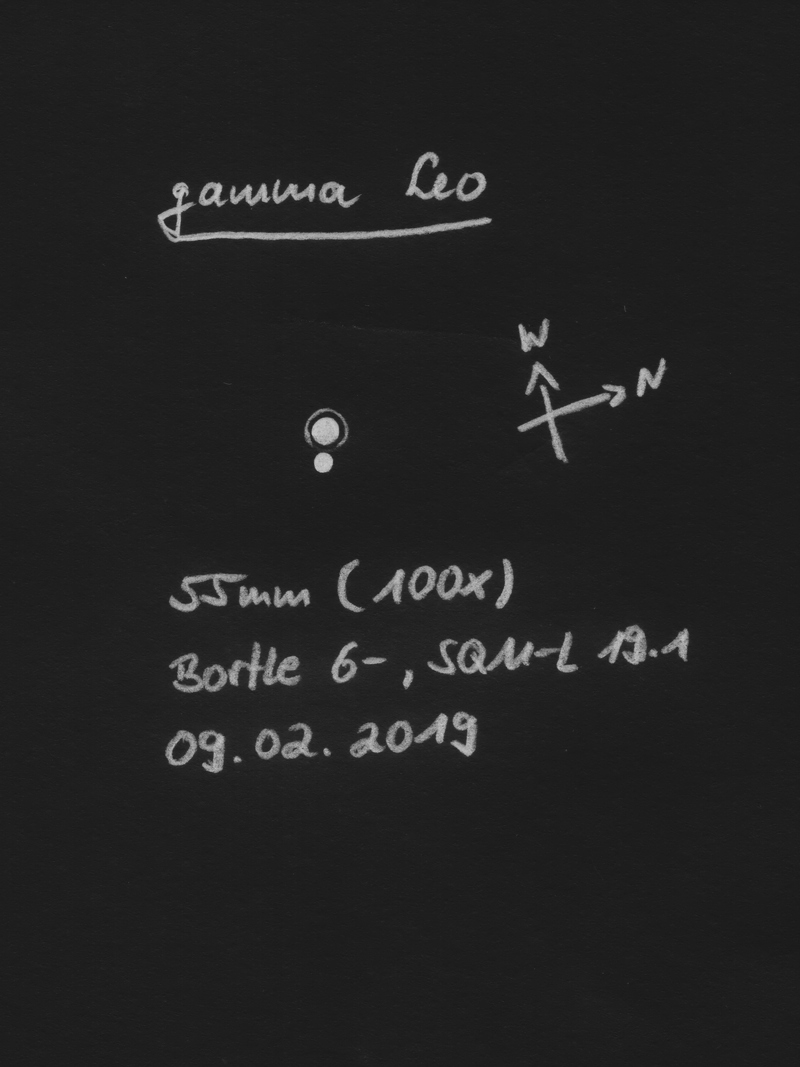
|
Robert Zebahl
Leipzig (Germany) |
55mm (59x) |
Very nice unequal double. A appeared yellow-orange, B rather white-bluish. |

|
Christopher Hay
Seeheim (Germany) |
60mm (58x) |
At 25x Algieba is already very elongated. At 58x a sliver of dark between the components, with clear brightness difference. At 70x split becomes more stable, but view not so pleasing as at 58x. Both components display vivid orange. |
|
Axel Tute
Küssaberg (Germany) |
70mm (88x) |
07.03.2009: At 88x magnification the stars are still coherent. At 117x magnification they are clearly separated. A & B have a slightly yellow colour. |

|
Robert Zebahl
Leipzig (Germany) |
70mm (100x) |
At 67x still a relatively close pair, but well separated with quite a clear difference in brightness. At 100x easy to separate and visible color difference: A yellowish to slightly orange, B white-yellowish. |
|
René Merting
Drachhausen (Germany) |
76mm (95x) |
Mondscheinnacht - bei 57x zwei goldgelbe Murmeln, die dicht aneinander kleben, die südöstliche, schwächere Murmel strahlt etwas tiefgelber - bei 95x dann zeigen sich beide Sterne mit unregelmäßig verlaufenden Beugungsringen und einem fetten gemeinsamen Halo - sie sind knapp getrennt erkennbar - B ist vielleicht eine Größenklasse schwächer - sehenswert |
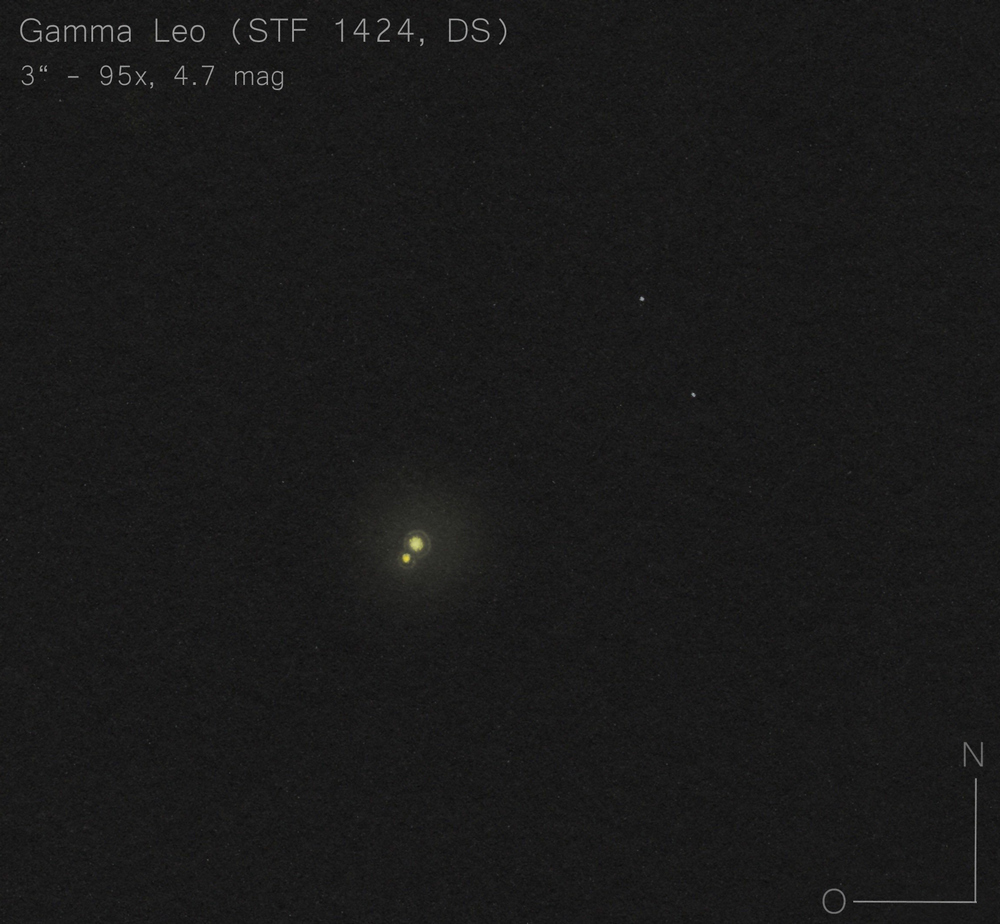
|
Sarah Gebauer
Germany |
100mm (80x) |
bei 80-fach fein, aber schön getrennt - Komponente A funkelt in einem warmen Goldgelb, die feinere und nur leicht schwächere Komponente B dicht östlich daneben zeigt einen ähnlichen Farbton, entsprechend ein bisschen weniger intensiv |

|
Robert Zebahl
Leipzig (Germany) |
102mm (125x) |
Very nicely separated with wonderful contrast in brightness and color. Primary component slightly orange, companion yellowish. |
|
Stefan Loibl
Rosenheim (Germany) |
102mm (164x) |
very bright double star, slight colour contrast |
|
Uwe Pilz
Leipzig (Germany) |
105mm (120x) |
schon bei 37x sehenswert; trennbar bei 55x; orange-blauweiß |
|
Robert Zebahl
Leipzig (Germany) |
120mm (66x) |
At 48x easily seen as double star. It appeared as '8'. At 66x pretty tight with visible difference in brightness. |
|
Winfried Kräling
Marburg (Germany) |
127mm (250x) |
08.04.2018: merklicher Helligkeitsunterschied, A = gelb-orange, B = gelb-orange |

|
Sarah Gebauer
Germany |
150mm (83x) |
bei 83x sauber getrennt, ein leichter Farbunterschied (Weiß und helles Gelb) sichtbar |

|
Axel Tute
Küssaberg (Germany) |
200mm (77x) |
11.05.2006: At 77x you can clearly see that it is a double star. An 8 but without a gap. At 167x a clear gap can be seen. A is slightly bluish. |

|
Mark McCarthy
Fremont (California/USA) |
317mm (277x) |
Algieba: Bright yellow and yellow-orange pair, 1 delta mag, 4-6" |
|
René Merting
Drachhausen (Germany) |
320mm (144x) |
bei 72x ist ein Stäbchen erkennbar - bei 144x zeigen sich zwei gelbe Murmeln, knapp getrennt |
|
René Merting
Drachhausen (Germany) |
320mm (240x) |
bei 240x sehe ich zwei ordentlich getrennte Sterne (naja, nicht wirklich Sterne, sondern wild zappelnde Glitzerbällchen) - Komponente A strahlt in einem zarten Gelb, B ist weiß - zurück auf 144x sehe ich nur ein Stäbchen mit leichter Einschnürung, so wild tanzen die Sterne |
|
Mark McCarthy
Fremont (California/USA) |
508mm (333x) |
Algieba. Very bright, A is yellow-orange and B is a blazing white orange, like a fire |
|
|
Frederik Wanink
Itterbeck (Germany) |
254mm |
|

|
|
|
★
|
STF1487, 54 Leo |
|
|
4m.5 |
6m.3 |
6.6" |
112° |
2020 |
Leo |
10h55m36.80s / +24°44'59.00" |
Robert Zebahl
Leipzig (Germany) |
55mm (27x) |
At 27x split, but very tight with noticeable difference in brightness. At 71x easy to separate. No visible color difference. |
|
Robert Zebahl
Leipzig (Germany) |
70mm (67x) |
2021-04-13: At 67x beautifully separated with clearly visible difference in brightness. Very attractive is the subtle color difference: light yellow & light blue. At 133x the color of the companion is a bit more pale: grey-blue. The primary component still shines in a beautiful light yellow. |
|
Axel Tute
Küssaberg (Germany) |
70mm (88x) |
07.03.2009: Separated at 88x magnification. A is slightly bluish. B is white. |

|
René Merting
Drachhausen (Germany) |
76mm (57x) |
Mondscheinnacht - bei 57x knapp getrennt - Komponente B steht im Südosten - A wirkt weißgelblich bis hellgelb, B ist mindestens 1.5 mag schwächer und wirkt stahlgrau, dadurch ein schöner Farbkontrast |

|
Sarah Gebauer
Germany |
100mm (80x) |
bei 49-fach haarscharf getrennt, die Hauptkomponente zeigt ein sehr klares, reines Weiß, der Begleiter als sehr dünner Punkt südöstlich davon wirkt etwas wärmer - bei 80-fach erscheint die Trennung geringfügig weiter, die Hauptkomponente hat nun einen schön warmgelben Farbhauch, der Begleiter wirkt dagegen kühl-weißlicher |
|
Winfried Kräling
Marburg (Germany) |
127mm (250x) |
13.03.2017: Hauptkomponente gelblich, Begleiter bläulich, deutlicher Helligkeitsunterschied. Ebenfalls bei V=60x getrennt. |

|
Axel Tute
Küssaberg (Germany) |
200mm (77x) |
07.04.2006: Separated at 77x magnification. But better at 167x. |
|
Mark McCarthy
Fremont (California/USA) |
317mm (277x) |
Bright white pair (4.5, 6.3) wide sep (6") |
|
Mark McCarthy
Fremont (California/USA) |
508mm (333x) |
54 Leo. Brilliant pair, light white-yellow stars, ~2 delta mag, wide |
|
|
Frederik Wanink
Itterbeck (Germany) |
254mm |
|
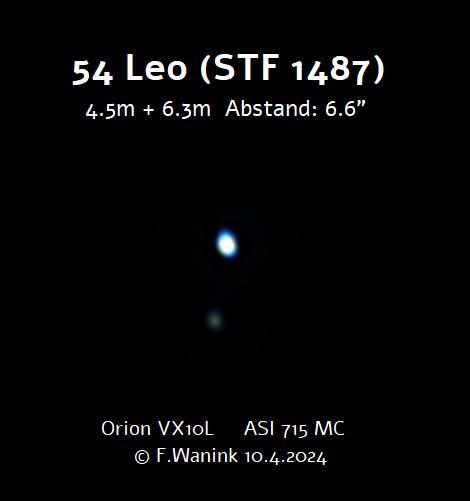
|
|
|
|
STF1495 |
|
|
7m.2 |
8m.8 |
33.8" |
36° |
2017 |
UMa |
10h59m49.47s / +58°54'23.30" |
Robert Zebahl
Leipzig (Germany) |
16x70 |
2023-02-15: Very pretty. The primary component shines in a light orange, the much fainter, nicely separated companion appears bluish. |
|
René Merting
Drachhausen (Germany) |
18x70 |
ein komfortabel getrenntes Sternpaar mit leichtem Farbkontrast - B steht versetzt nördlich von A und ist 1.5 bis 2 Magnituden schwächer |
|
René Merting
Drachhausen (Germany) |
76mm (29x) |
bei 29x einfach zu trennen - bei 57x wirkt A auf den Punkt genau gelb, starker Farbkontrast zur B-Komponente, die graublau wirkt |

|
René Merting
Drachhausen (Germany) |
100mm (20x) |
bei 32x ein weit getrenntes Paar - Komponente B im NO ist knapp zwei Magnituden schwächer - A strahlend weiß, B die graue Maus, wie es sich gehört für die schwächere Komponente - zurück auf 20x immernoch ordentliche Trennung, der Helligkeitsunterschied wirkt nicht mehr ganz so groß |
|
Sarah Gebauer
Germany |
100mm (49x) |
schon bei 21-fach fein getrennt und leicht gelb-graublau - bei 49-fach leuchtet A nun stärker und orangegold, B etwas stärker grau mit weniger Blauhauch |

|
Sarah Gebauer
Germany |
254mm (96x) |
bei 96-fach ist der DS weit getrennt – die südliche, hellere Komponente zeigt sich leicht strohgelb, die nördliche eher grau |
|
René Merting
Drachhausen (Germany) |
320mm (45x) |
bei 45x weit getrennt - ein schönes farbiges Kontrastpaar - Komponente B im NO ist gut 1.5 Größenklassen schwächer und strahlt kupfergrau, A dagegen ist weißgelb |
|
|
|
★★
|
STFA19, 84 Leo, tau Leo |
|
AB |
5m.0 |
7m.5 |
89.2" |
181° |
2019 |
Leo |
11h27m56.23s / +02°51'22.50" |
Christopher Hay
Seeheim (Germany) |
7x50 |
On tripod. Comfortably split. Component A is mildly orangish-yellow.
Can't quite eke out 83 Leo's secondary (NELM 5m0, elevation 40°). |
|
Christopher Hay
Seeheim (Germany) |
15x45 |
Binoculars with internal stabilisation, handheld. Wide pair. Component A dull golden-yellow, component B seems bluish. Attractive.
In 15x60 on tripod very wide. Component A very mild orange, B grey-blue. Fine sight in 3.3° FOV together with well-split 83 Leo. |
|
Robert Zebahl
Leipzig (Germany) |
16x70 |
2021-03-02: Splendid sight together with the double star 83 Leo as well as 82 Leo. Beautiful star field. Tau Leo beautifully separated with significant difference in brightness. Yellowish & bluish. |
|
Robert Zebahl
Leipzig (Germany) |
55mm (16x) |
Wonderful double with slight color contrast in a very nice field. Together with 83 Leo stunning view. Noticeable unequal. A appeared white-yellowish with a hint of orange, B grey-bluish. |

|
René Merting
Drachhausen (Germany) |
76mm (29x) |
Mondscheinnacht - bei 29x ein schönes Doppel-Doppel zusammen mit STF 1540 weiter westlich - Tau Leo ist komfortabel getrennt erkennbar - Komponente A strahlt Ampelgelb, Komponente B ist 2 Größenklassen schwächer und strahlt stahlgrau mit einem Stich ins Blaue |

|
Mark McCarthy
Fremont (California/USA) |
80mm (13x) |
Finder split, the A star is prismatic in color effects, bluish B |
|
Sarah Gebauer
Germany |
100mm (21x) |
bei 20-fach zeigt die nördliche A-Komponente einen schön warmgoldenen Farbton, die südliche B-Komponente dagegen erscheint deutlich schwächer und in einem kühlen Grau mit einem Hauch von Blau - ein schöner Farbkontrast und zudem mit STF 1540 zusammen in einem GF |

|
Mark McCarthy
Fremont (California/USA) |
317mm (340x) |
Bright yellow A, bluish B, very widely separated |
|
|
|
★
|
STF1603 |
|
AB |
7m.8 |
8m.3 |
22.2" |
83° |
2021 |
UMa |
12h08m07.07s / +55°27'50.70" |
Robert Zebahl
Leipzig (Germany) |
16x70 |
2022-03-27: Medium bright at moderate separation and slight difference in brightness. Slight color difference: yellowish & slightly bluish. |
|
René Merting
Drachhausen (Germany) |
18x70 |
ein Sternpaar, das zu gefallen weiß, etwas mehr als knapp getrennt - B im Nordosten wirkt eine viertel Größenklasse schwächer - leichter Farbunterschied, wobei B Zartorange, Braunweiß, Ockergrau oder so wirkt, naja |
|
Robert Zebahl
Leipzig (Germany) |
70mm (22x) |
2020-04-07: At 22x quite apparent double star in rather poor surrounding. Nice separation with little difference in brightness. Primary component appeared slightly orange, companion grey-bluish. At 44x similar view in color appearance. |
|
Sarah Gebauer
Germany |
100mm (45x) |
schwach, sauber getrennt, nahezu gleich hell, die westliche Komponente ist minimal heller |
|
René Merting
Drachhausen (Germany) |
320mm (45x) |
bei 45x gut getrennt - Komponente B im Osten wirkt grauorange gegen die weiß strahlende Komponente A - Helligkeitsunterschied eine halbe Größenklasse - ein schön isoliert stehendes Sternpaar |
|
|
Frederik Wanink
Itterbeck (Germany) |
254mm |
|

|
|
|
★★
|
STFA21, 17 Com, AI Com |
|
AB |
5m.2 |
6m.6 |
146.4" |
251° |
2018 |
Com |
12h28m54.72s / +25°54'46.40" |
Christopher Hay
Seeheim (Germany) |
7x45 |
Handheld. Well split, strong compact pair. Component A seems bluish, B warmer. At this low power 17 Com is the most double-starish pair in Melotte 111, the Coma Star Cluster. Fantastic star-strewn 8.6° FOV with the stars of the cluster.
A physical double at a distance to us of 238 light years. |
|
René Merting
Drachhausen (Germany) |
8x25 |
ein helles, weit getrenntes Sternpaar - Komponente B im Westen ist halb so hell und wirkt grau |
|
René Merting
Drachhausen (Germany) |
320mm (72x) |
bei 72x ein weit auseinander stehendes Paar - schöner Farbkontrast, A weißblau, B im SW leicht gelblich schimmernd |
|
|
|
★★
|
STF1657, 24 Com |
|
AB |
5m.1 |
6m.3 |
20.2" |
272° |
2018 |
Com |
12h35m07.76s / +18°22'37.40" |
Christopher Hay
Seeheim (Germany) |
15x45 |
Binoculars with internal stabilisation, handheld. Clean split. Strong pair dominating 4.5° FOV. Primary pale yellow. Secondary too close for clear colour impression but certainly colder.
A physical double at a distance to us of 450 light years. |
|
René Merting
Drachhausen (Germany) |
18x70 |
ein wunderschönes eng stehendes FG-Sternpaar - Komponente B im Westen ist 1.5 Magnituden schwächer - A strahlt weißgelb, B wirkt dagegen etwas unterkühlt |
|
Robert Zebahl
Leipzig (Germany) |
70mm (22x) |
2020-04-04: Splendid sight! Very nice difference in brightness and color: pale orange & grey-blue. |
|
Mark McCarthy
Fremont (California/USA) |
80mm (94x) |
24 Com. Lovely bright orange A and blue B, wide. Very deserving of its showcase reputation |
|
Robert Zebahl
Leipzig (Germany) |
102mm (28x) |
Very beautiful view with moderate distance and difference in brightness. A: glossy, light orange, B: white- bluish. |
|
Christopher Hay
Seeheim (Germany) |
125mm (64x) |
Well apart. Hugely dominant in 1.3° FOV. Primary slightly orangish yellow, secondary ice blue, extremely attractive. |
|
Robert Zebahl
Leipzig (Germany) |
200mm (60x) |
Well split with obvious difference in brightness. Fainter component appeared bluish, the brighter one slightly orange. |
|
Mark McCarthy
Fremont (California/USA) |
203mm (205x) |
Very pretty bright light orange and fainter blue, wide separation. Such a sight! |
|
|
|
★★
|
STF1877, epsilon Boo, Izar |
|
AB |
2m.6 |
4m.8 |
2.9" |
347° |
2020 |
Boo |
14h44m59.14s / +27°04'29.90" |
Robert Zebahl
Leipzig (Germany) |
55mm (125x) |
The fainter component was seen as permanent brightening on the first diffraction ring of the primary component. |
|
Robert Zebahl
Leipzig (Germany) |
60mm (192x) |
Easy to split, whereby the much fainter component lies on the first diffraction ring of the primary component. The primary component itself appeared slightly yellowish. |

|
Robert Zebahl
Leipzig (Germany) |
70mm (133x) |
Easy to split, very unequal. A appeared in pale orange, B was visible as a very tiny, grey star on the first diffraction ring of component A. |
|
Christopher Hay
Seeheim (Germany) |
76mm (100x) |
AB: Secondary sits on the first diffraction ring of the primary, and appears there as a fine blue point. Further magnification not useful, merely darkens the image. |
|
Mark McCarthy
Fremont (California/USA) |
80mm (150x) |
Izar: Dull yellow-orange A and dull orange B, nice round images so split easily. No parallax for the B star, so it's uncertain if physical |
|
René Merting
Drachhausen (Germany) |
100mm (142x) |
bei 107x erscheint die B-Komponente nordwestlich leicht angesetzt an der gelblich strahlenden Komponente A - bei 142x dann ist die Trennung komplett, B liegt schön auf einem abgesetzten Beugungskranz von Komponente A |
|
Stefan Loibl
Rosenheim (Germany) |
102mm (205x) |
nice contrast yellow-orange/blue |
|
Robert Zebahl
Leipzig (Germany) |
102mm (224x) |
2021-05-12: Primary component appears in bright orange, the well separated, much fainter companion at 187x grey-bluish, at 224x and higher in a very nice, pale blue. |
|
René Merting
Drachhausen (Germany) |
107mm (120x) |
bei 120x gelingt die Trennung - die B-Komponente im Norden ist mindestens 2 Magnituden schwächer - A strahlt schön Gelbweiß, B ist Aschegrau |
|
Uwe Pilz
Leipzig (Germany) |
120mm (150x) |
Orange und blau, sehr lohnend |

|
Robert Zebahl
Leipzig (Germany) |
120mm (192x) |
At 85x the fainter component was easily visible but not separated. At 192x well split. The fainter component was almost on the first diffraction ring of the primary component. Quite big difference in brightness. I did not looked at the color of the components. |
|
Sarah Gebauer
Germany |
150mm (166x) |
weder mit 166x noch mit 250x im April 2020 getrennt |
|
Gerd Kohler
Langenzenn (Germany) |
254mm (346x) |
Gelblich - leicht bläulich. Enges Paar. Deutlicher Helligkeitsunterschied. |
|
Frederik Wanink
Itterbeck (Germany) |
254mm (640x) |
deutl. Farbkontrast blau gelb |

|
Christopher Hay
Seeheim (Germany) |
280mm (180x) |
Clearly split despite poor seeing. Slightly bluish impression of secondary at 180x becomes much clearer at 240x, indeed transforms into a charming, very light ultramarine blue or lapis lazuli. |
|
Sarah Gebauer
Germany |
280mm (250x) |
waberndes Seeing, aber eindeutig und zum ersten Mal getrennt - A erscheint leicht gelblich, B steht abgesetzt in weißlichem Ton daneben |

|
Mark McCarthy
Fremont (California/USA) |
317mm (553x) |
Izar: Yellow-orange and blue, very pretty, as always |
|
Karsten Kopp
Köln (Germany) |
600mm (257x) |
Sehr einfaches und auffälliges Objekt. Dieser Doppelstern war für mich an diesem Abend das Highlight. Vor allem, weil der schwächere hellblaue Stern gerade knapp neben den Spikes des helleren gelben Sterns steht. |

|
|
Berthold Fuchs
Wiesbaden (Germany) |
130mm |
magnificent DS |

|
Frederik Wanink
Itterbeck (Germany) |
254mm |
|

|
|
|
★
|
xi Boo, 37 Boo |
STF1888 |
AB |
4m.8 |
7m.0 |
5.0" |
296° |
2021 |
Boo |
14h51m23.38s / +19°06'01.70" |
|
|
|
STF1888 |
AC |
4m.8 |
13m.8 |
71.3" |
340° |
2015 |
|
|
|
|
|
STF1888 |
AD |
4m.8 |
11m.7 |
160.8" |
286° |
2015 |
|
|
|
|
|
ARN11 |
AE |
4m.8 |
8m.7 |
271.5" |
98° |
2015 |
|
|
|
|
|
ARN11 |
AF |
4m.8 |
9m.2 |
335.4" |
39° |
2020 |
|
|
|
|
|
STF1888 |
BC |
7m.0 |
13m.8 |
67.0" |
343° |
2016 |
|
|
|
|
|
STF1888 |
BE |
7m.0 |
8m.7 |
273.1" |
99° |
2016 |
|
|
|
|
Robert Zebahl
Leipzig (Germany) |
70mm (44x) |
AB: 2020-04-24: Beautifully separated with quite a large difference in brightness in a lovely star field. The primary component shines yellowish with a faint companion. |
|
Mark McCarthy
Fremont (California/USA) |
80mm (94x) |
AB: Yellow A and orange B, 2 delta mag, nice. Only 22 light years distant, it is physical with a 298-year period, and will tighten the next 30 years |
|
Sarah Gebauer
Germany |
150mm (83x) |
AB: die 6'' entfernten Komponenten A und B konnten mühelos bei 83x getrennt werden, Komponente E war zu sehen, C, D und F waren nicht sichtbar |
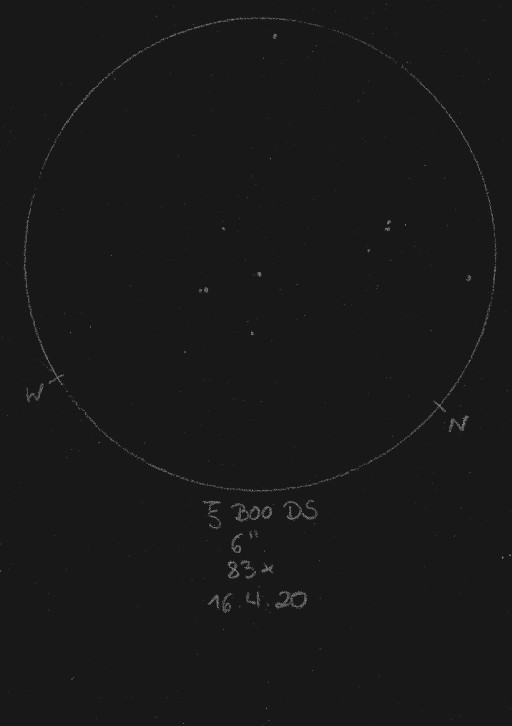
|
Mark McCarthy
Fremont (California/USA) |
508mm (333x) |
AB: Xi Boo. Short period. Richly colored yellow and orange stars, ~1 delta mag, ~5" separation, with several other stars in view. Very pretty |
|
Karsten Kopp
Köln (Germany) |
600mm (180x) |
AB: Ein recht schöner Doppelstern, wobei neben dem Helligkeitsunterschied von 2,2 mag auch die Sternfarben ein schönes Gesamtbild geben. Der hellere Stern erstrahlt gelblich weiß und der schwächere orangegelb.
Hier handelt es sich auch um ein recht nahes System mit 21,9 Lichtjahren Entfernung. |

|
|
Frederik Wanink
Itterbeck (Germany) |
254mm |
AB |

|
|
|
★★
|
STFA27, delta Boo, 49 Boo |
|
AB |
3m.6 |
7m.9 |
105.0" |
78° |
2021 |
Boo |
15h15m30.16s / +33°18'53.40" |
Christopher Hay
Seeheim (Germany) |
15x45 |
Handheld, binoculars with internal stabilisation. Very wide. Component A is of a slight yellow-orange hue, its companion too weak (NELM in target area: 5m0) for colour impression.
Nice in 4.5° FOV with Mu Boo AB, which is visibly slightly wider than Delta Boo and whose component B is slightly brighter than that of Delta Boo.
Delta Boo is a physical double at a distance to us of 122 light years. |
|
René Merting
Drachhausen (Germany) |
18x70 |
ein sehr ungleiches, weit auseinander stehendes Sternpaar - Komponente A im Westen strahlt gleißend cremegelb, die wesentlich schwächere Komponente B im Osten ist weißgrau bis bräunlich |
|
Robert Zebahl
Leipzig (Germany) |
70mm (22x) |
2020-04-24: Widely separated pair with large difference in brightness. Less striking. The bright primary component shines in a bright yellow. |
|
Mark McCarthy
Fremont (California/USA) |
80mm (13x) |
Split in 80mm finder. Very wide pair, very bright A, 3 delta mag B. Orange-yellow and blue-white B |
|
Mark McCarthy
Fremont (California/USA) |
80mm (94x) |
Delta Boo. Wide, large delta mag B, a 76,000-period pair! |
|
Sarah Gebauer
Germany |
100mm (49x) |
bei 49-fach zeigt A ein schönes, zartes Gelb, der weit entfernte Begleiter ist sehr fein, wesentlich schwächer und schafft es nicht über einen grauen Farbeindruck hinaus |
|
René Merting
Drachhausen (Germany) |
107mm (30x) |
bei 30x deutlich getrennt - Komponente A strahlt ein einem seidenen Gelb, B ist mehr als zwei Größenklassen schwächer und wirkt weißlich |
|
Mark McCarthy
Fremont (California/USA) |
203mm (205x) |
Bright star with many nearby faint stars. Didn't bother trying to figure out which are which. |
|
|
Frederik Wanink
Itterbeck (Germany) |
254mm |
|
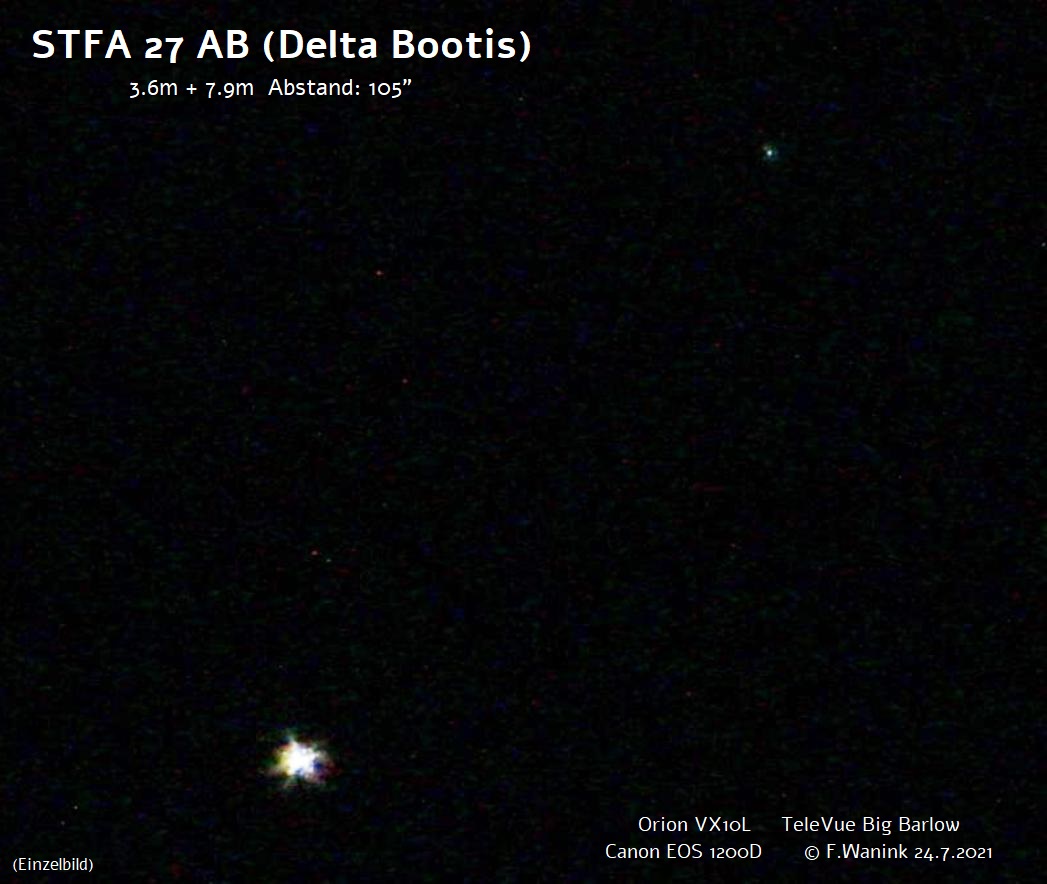
|
|
|
|
STF2010, kappa Her, 7 Her |
|
AB |
5m.1 |
6m.2 |
26.8" |
14° |
2020 |
Her |
16h08m04.55s / +17°02'49.20" |
|
|
|
|
AC |
5m.1 |
13m.4 |
62.7" |
212° |
2016 |
|
|
René Merting
Drachhausen (Germany) |
16x70 |
AB: ein eng stehendes Pärchen mit einem leichten Farbkontrast, weil Komponente B im Norden mindestens eine Größenklasse schwächer erscheint - dadurch wirkt B gegenüber nicht rein weiß, sondern dumpf grau-weiß |
|
René Merting
Drachhausen (Germany) |
76mm (29x) |
AB: bei 29x ein ordentlich getrenntes Paar - Komponente A im Südwesten ist eine dreiviertel Größenklasse heller und strahlt hellgelb, bei B kann ich keinen Farbunterschied erkennen |
|
René Merting
Drachhausen (Germany) |
100mm (20x) |
AB: bei 20x leicht zu trennen - zwei richtig helle Sterne, B im Norden eine halbe Größenklasse schwächer - bei 64x schöner Farbkontrast, Komponente A satt gelb, B weiß mit einem Stich ins orange |
|
Sarah Gebauer
Germany |
100mm (49x) |
AB: 01.10.23: bei 21-fach schon ein sehr markanter, heller Doppelstern, der mit einem sehr warmen, dunkel creme- bis pfirsichgelben Farbton aus dem feinen Sternfeld heraussticht - bei 49-fach sind die beiden Komponenten nahe gleich hell, komfortabel getrennt, wenn auch dicht beieinander, der Begleiter erscheint etwas kleiner, feiner und dunkler |

|
René Merting
Drachhausen (Germany) |
107mm (30x) |
AB: bei 30x ein auffallendes Sternpaar, A im Süden wirkt hellgelb, B mit einem schönen Farbkontrast, der nicht greifbar ist, sondern eher changierend - Trennung ordentlich - bei 144x ist B dann weißgelblich und die beiden Sterne zeigen sich weiter als schickes Farbpaar |
|
Axel Tute
Küssaberg (Germany) |
200mm (77x) |
AB: 02.07.2006: Nice pair. A is blue. B is green. Separated with the 26mm Plössl (77x). The estimated PA is 10°. |
|
Karsten Kopp
Köln (Germany) |
600mm (135x) |
AB: Sehr einfacher Doppelstern.
Komponente A erscheint orange, während die Komponente B weiß scheint. |
|
|
|
★★
|
STF2140, alpha Her, 64 Her, Ras Algethi |
|
AB |
3m.5 |
5m.4 |
4.7" |
103° |
2020 |
Her |
17h14m38.86s / +14°23'24.90" |
|
|
Christopher Hay
Seeheim (Germany) |
36mm (50x) |
At 50x secondary detaches momentarily from first diffraction ring of primary as the tiniest pinprick of light, delta-mag seems massive.
At 66x separation becomes much clearer. Can hold secondary 80% of the time as a fine point on the outer rim of the first diffraction ring. Primary is orange-yellow, secondary far too faint in this aperture for any kind of colour impression. Rather charming in a strange sort of way. See for comparison simultaneous observation with 210mm at 68x. |
|
Robert Zebahl
Leipzig (Germany) |
55mm (41x) |
Well split with noticeable difference in brightness. |
|
René Merting
Drachhausen (Germany) |
100mm (64x) |
bei 32x ist noch nichts erkennbar - bei 64x wird östlich von Rasalgethi der schwache Begleiter B knapp getrennt sichtbar - A ist strahlend gelb, B mit einer Tendenz zum gelb, eher ein warmes weiß |
|
Uwe Pilz
Leipzig (Germany) |
105mm (88x) |
himmelblau und hellgelb, getrennt bei 53x |

|
Uwe Pilz
Leipzig (Germany) |
105mm (288x) |
gelb-lachsfarben |
|
René Merting
Drachhausen (Germany) |
107mm (86x) |
bei 30x zeigt sich das Paar noch zusammen und zeigt ein auffallendes Gelb - bei 86x präsentiert sich A in Zitronenschalengelb, im Südosten zeigt sich knapp getrennt die B-Komponente, zwar deutlich schwächer, aber immernoch hell und auch farblich ein schwächerer Abklatsch von A in Hellgelb |
|
Robert Zebahl
Leipzig (Germany) |
120mm (100x) |
Easily split with noticeable difference in brightness. A: intensively orange colored, B: slightly orange. |
|
Christopher Hay
Seeheim (Germany) |
125mm (133x) |
At 133x split well and showing a fine colour contrast, orange / grey-blue. Each step to 160x, 200x and finally 266x benefits the aesthetic experience, drawing the pair apart and making the colour contrast clearer. At 266x primary is yellowish orange and secondary exhibits a fine grey-blue. Fine diffraction pattern at 266x with first ring around secondary and hint of a second ring around primary. |
|
Karsten Kopp
Köln (Germany) |
140mm (94x) |
Konnte erst mit 94-facher Vergrößerung gut getrennt wahrgenommen werden. |
|
Sarah Gebauer
Germany |
150mm (85x) |
bei Halbmond auf der Schwäbischen Alb: sehr eng, aber sauber getrennt, eine Komponente ist viel heller und größer, mein Farbeindruck ist allerdings unerwartet eher gelb |
|
Sarah Gebauer
Germany |
150mm (160x) |
richtig gold, es strahlt mich richtiggehend an, auch sehr schön getrennt, ein toller Doppelstern! |
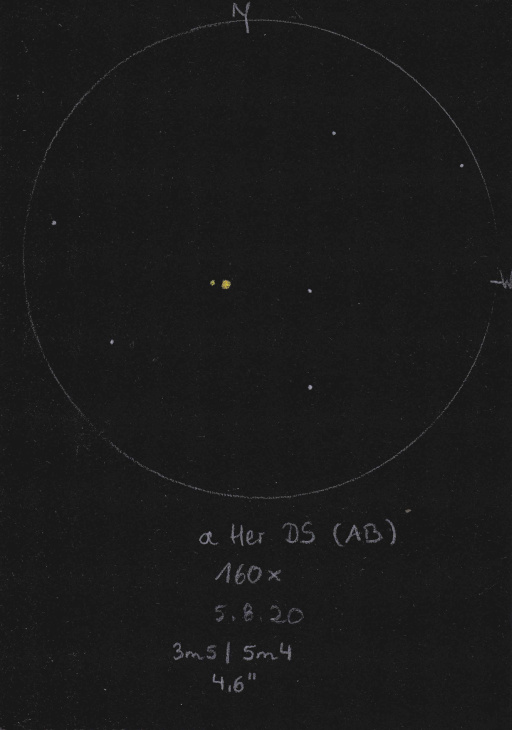
|
Mark McCarthy
Fremont (California/USA) |
152mm (175x) |
Rasalgethi. Wow best ever view, perfect disks with no flaring. Light orange A and 2 delta mag light aqua B. Physical with a 3600-year period |
|
Mark McCarthy
Fremont (California/USA) |
203mm (667x) |
Rasalgethi. 8" inch mask due to seeing. AB orange and blue 4 delta mag. Faint AD seen very wide separation. pretty star. |
|
Christopher Hay
Seeheim (Germany) |
210mm (68x) |
Despite the primary being a little bloated in mediocre seeing, the secondary is set off clearly as a fine pinprick of light. Both are orangish-yellow. A very charming sight. See for comparison simultaneous observation with 36mm at 66x. |
|
Sarah Gebauer
Germany |
254mm (96x) |
bei 96-fach ein sehr enges Pärchen mit einem weiten Lichthof, das hübsch umkreist wird von etwa einem halben Dutzend schwacher Sterne – beide Komponenten leuchten in einem warmen Gold, die Hauptkomponente deutlich heller und stärker |

|
Christopher Hay
Seeheim (Germany) |
254mm (170x) |
At this power the components are drawn far enough apart, and there is enough exit pupil with this aperture, to clearly see a charming contrast of two different types of yellow. The primary is distinctly orangish, while the secondary is lemon yellow. The FOV of a little under 0.5° frames the pair well. At lower powers the primary swamps the secondary and both appear similarly orange-yellow. |
|
Frederik Wanink
Itterbeck (Germany) |
254mm (640x) |
gelblich und bläulicher Stern |

|
Mark McCarthy
Fremont (California/USA) |
317mm (277x) |
Rasalgethi, Bright orange A & pale green much fainter B. Very nice! |
|
Karsten Kopp
Köln (Germany) |
600mm (135x) |
Leicht zu trennen. Komponente A erscheint orange, Komponente B gelblich. |
|
Karsten Kopp
Köln (Germany) |
600mm (180x) |
Doppelstern ist gut zu trennen. Komponente A erstrahlt orange und Komponente B gelblich. |
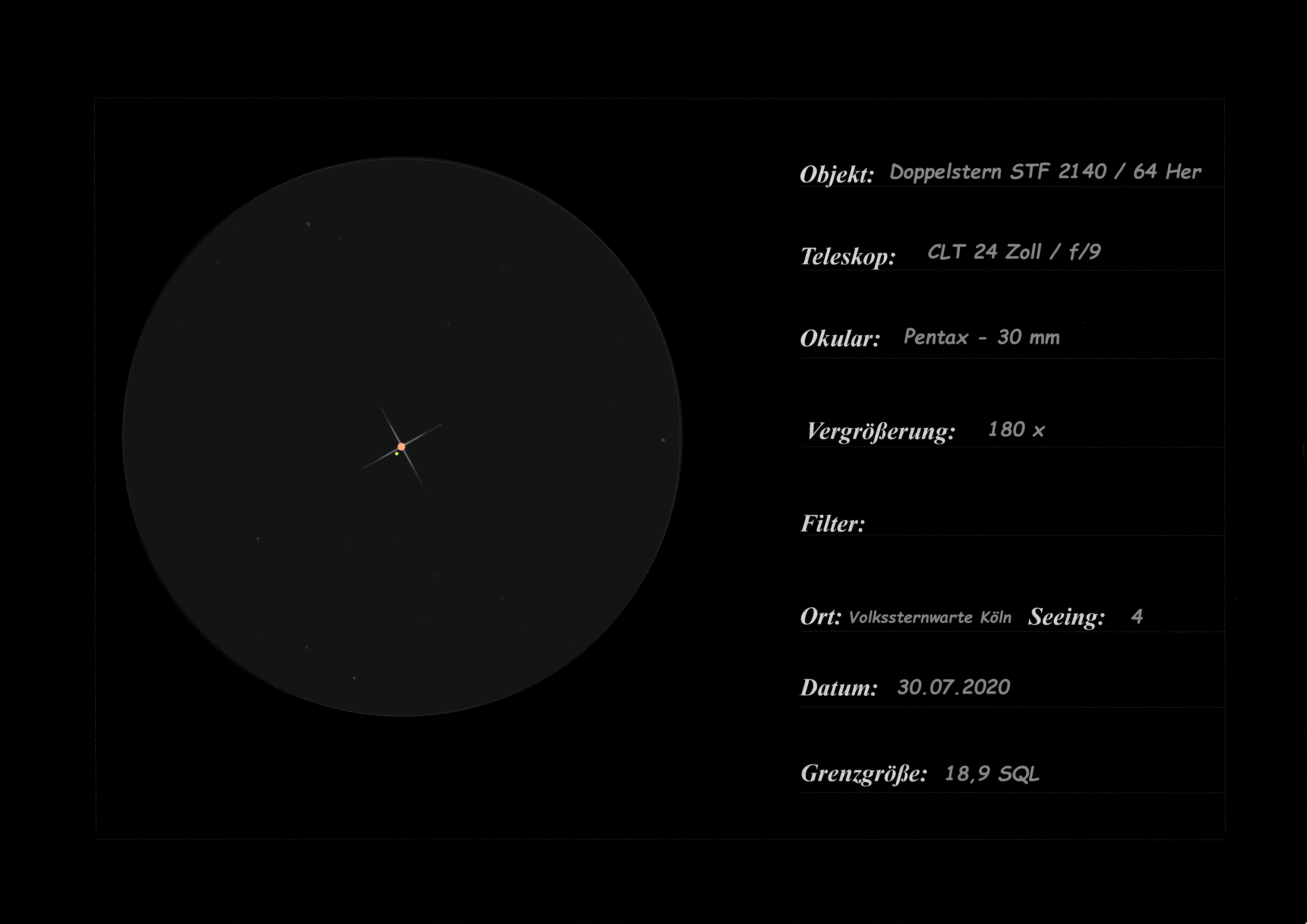
|
|
Frederik Wanink
Itterbeck (Germany) |
254mm |
|

|
Jens Leich
Germany |
130mm |
|

|
|
|
★
|
STF2264, 95 Her |
|
|
4m.8 |
5m.2 |
6.4" |
255° |
2020 |
Her |
18h01m30.41s / +21°35'44.80" |
Axel Tute
Küssaberg (Germany) |
70mm (117x) |
16.07.2009: Both light yellow. |

|
René Merting
Drachhausen (Germany) |
100mm (32x) |
bei 32x mein erster Eindruck ist, dass zwei annähernd gleichhelle sehr eng stehende Sterne mich wie zwei Augen anschauen, das unmittelbare Sternumfeld passt schön und verleiht dem Doppel eine hervorgehobene Stellung - Komponente B im Westen ist nur minimal schwächer als A - in guten Momenten ist die Trennung sehr eindeutig erkennbar |
|
René Merting
Drachhausen (Germany) |
100mm (64x) |
bei 64x zwei helle, knapp getrennte Sterne - die schwächere westliche Komponente zeigt ein schönes, helles Gelb und wirkt dadurch leicht schwächer - zurück auf 32x ist eine 8 mit deutlicher Einschnürung erkennbar - der Farbunterschied ist ebenfalls deutlich |
|
Sarah Gebauer
Germany |
100mm (80x) |
24.09.23: bei 49x ein enger, getrennter DS, bestehend aus zwei sehr hellen, dominanten Murmelchen, die buttergelb strahlen - bei 80x wird der Anblick schöner, der Farbton intensiviert sich ins Dunklere, die beiden ganz engen Lichtpünktchen sind das Highlight im Gesichtsfeld, das Umfeld hält sich sehr zurück - durch den geringen Abstand der Komponenten etwas Besonderes |

|
Uwe Pilz
Leipzig (Germany) |
105mm (288x) |
|

|
Karsten Kopp
Köln (Germany) |
140mm (94x) |
Konnte erst mit 94-facher Vergrößerung gut getrennt wahrgenommen werden. |
|
Sarah Gebauer
Germany |
150mm (54x) |
zwei enge, hübsche Glanzpünktchen, die ich zuvor ziemlich lange in dem hellen Sterntrapez gesucht habe |
|
Robert Zebahl
Leipzig (Germany) |
152mm (49x) |
2020-06-23: At 49x eye catching double star, relatively tight with rather small difference in brightness. Beautiful color impression, which was even better visible at 69x: yellowish and yellowish-orange. |
|
Mark McCarthy
Fremont (California/USA) |
508mm (667x) |
95 Her. Orange and blue, wide, bright. |
|
Karsten Kopp
Köln (Germany) |
600mm (135x) |
Sehr einfaches und auffälliges Objekt. Kein Helligkeitsunterschied erkennbar. |
|
|
Berthold Fuchs
Wiesbaden (Germany) |
130mm |
close DS |

|
Frederik Wanink
Itterbeck (Germany) |
254mm |
|

|
|
|
|
70 Oph, P Oph, STF2272 |
|
AB |
4m.2 |
6m.2 |
6.9" |
121° |
2021 |
Oph |
18h05m27.37s / +02°29'59.30" |
|
|
Uwe Pilz
Leipzig (Germany) |
16x70 |
nicht einfach; der helle ist gelb |

|
Christopher Hay
Seeheim (Germany) |
25x80 |
Clean split, component A appears yellowish.
70 Oph is the left nostril of the bull in the old constellation Taurus Poniatowski (Poniatowski’s Bull). On the connections to 67, 68 and 73 Oph see the entry on 67 Oph. |
|
René Merting
Drachhausen (Germany) |
100mm (64x) |
bei 32x wirkt der Stern nicht rund, sondern ein wenig nach SO verschmiert - bei 64x dann eindeutig ein knapp getrenntes schön anzusehendes Pärchen - Komponente A hell-gelb, B orange-gelb |
|
Jörg S. Schlimmer
Germany |
127mm (136x) |
easy to split |

|
Sarah Gebauer
Germany |
150mm (85x) |
ein ganz leicht goldener Farbeindruck des Sternpaares, die Sterne stehen recht dicht beisammen und sind dennoch schön getrennt |

|
Robert Zebahl
Leipzig (Germany) |
200mm (80x) |
Conditions in the target region: SQM-L 20.1
Well split at 80x. Brighter component appeared white, fainter one slightly orange. |
|
|
Berthold Fuchs
Wiesbaden (Germany) |
130mm |
difficult DS |
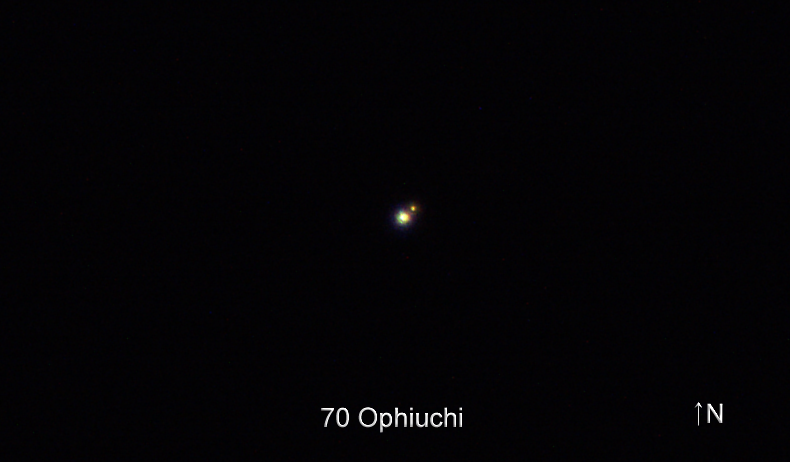
|
|
|
★★
|
STFA38, zeta Lyr, zeta 1/2 Lyr, 6/7 Lyr |
|
AD |
4m.3 |
5m.6 |
43.7" |
150° |
2018 |
Lyr |
18h44m46.36s / +37°36'18.40" |
Christopher Hay
Seeheim (Germany) |
7x45 |
Handheld. Clearly split, almost wide. Primary bluish-white. Fantastic 8.6° FOV together with Eps1/2 and Delta1/2 Lyrae. One of the best doubles for 7x. |
|
Christopher Hay
Seeheim (Germany) |
10x42 |
Clearly separated. Colour contrast between bluish A and orangish D is there if one knows it, but not as striking as in 15x45 binoculars. |
|
Sarah Gebauer
Germany |
12x42 |
gut getrennt, mit schönem Helligkeitsunterschied und weißem Farbeindruck - zusammen mit Vega, ihrem weiten Halo und dem einfachen Epsilon-Lyrae-Doppel ein wundervoller Anblick |

|
Christopher Hay
Seeheim (Germany) |
15x45 |
Component A clear blue-white, component D very pale tangerine orange. Wide split. Colour contrast seems even greater than that of nearby Delta 1/2 Lyrae. Physical double. |
|
René Merting
Drachhausen (Germany) |
76mm (29x) |
bei 29x ein sehr auffälliges Sternpaar, ordentlich getrennt - ein extrem schöner, dezenter Farbkontrast, A ist hellst gelb, D strahlt hell mintfarben, aber nur, wenn man nicht genau drauf schaut, sondern nur beiläufig - bei 57x verstärkt sich der Farbeindruck, vor allem, wenn man die Sterne leicht unscharf stellt, A ist dann samtgelb, B wirkt nicht mehr mintgrün sondern zart braunorange |
|
René Merting
Drachhausen (Germany) |
76mm (29x) |
bei 29x ein schön getrenntes Pärchen - D im Südosten ist 1.5 Magnituden schwächer und wirkt blaugrau gegen die weißgelbe A-Komponente |
|
Mark McCarthy
Fremont (California/USA) |
80mm (13x) |
Zeta 2 Lyr. Slightly greenish-white stars. Best view in finder, cleaner. Wide, 1 delta mag. |
|
René Merting
Drachhausen (Germany) |
100mm (20x) |
bei 20x weit getrennt, Komponente A weißlich, D leicht gelblich |
|
Sarah Gebauer
Germany |
100mm (21x) |
bei 20-fach auf den ersten Blick farblos bzw. warmweiß - ein sehr dominantes Pärchen in der Sternumgebung durch seine Helligkeit - mit etwas Geduld beim Beobachten zeigt sich ein gelber Farbhauch |
|
Sarah Gebauer
Germany |
100mm (80x) |
ein typisches Augenpaar, der nördliche Stern leuchtet leicht heller als der südliche |
|
Axel Tute
Küssaberg (Germany) |
100mm (217x) |
11.10.2023: Simple. No colours noted. |

|
Uwe Pilz
Leipzig (Germany) |
105mm (88x) |
weiß-orange |

|
Sarah Gebauer
Germany |
150mm (85x) |
weit getrennt, unspektakulär |
|
Winfried Kräling
Marburg (Germany) |
152mm (175x) |
|

|
Mark McCarthy
Fremont (California/USA) |
152mm (175x) |
Wide, white-yellow stars, one delta |
|
René Merting
Drachhausen (Germany) |
320mm (45x) |
bei 45x ein helles Sternpaar mit leichtem Farbkontrast - die südöstlich stehende B-Komponente wirkt eine halbe Größenklasse schwächer und strahlt zartgelb, A dagegen wirkt weiß |
|
|
Frederik Wanink
Itterbeck (Germany) |
254mm |
|

|
|
|
★★
|
STT525 & SHJ282 |
STT525 |
AB |
6m.1 |
9m.1 |
1.8" |
130° |
2015 |
Lyr |
18h54m52.52s / +33°58'06.90" |
|
|
|
SHJ282 |
AC |
6m.1 |
7m.6 |
45.4" |
349° |
2018 |
|
|
|
|
|
SHJ282 |
AD |
6m.1 |
11m.0 |
214.8" |
295° |
2015 |
|
|
Christopher Hay
Seeheim (Germany) |
10x42 |
SHJ282 (AC): Stabilised binoculars, handheld. Wide split, the A component yellowish. Alias South 282. According to Stelledoppie a physical double. |
|
Robert Zebahl
Leipzig (Germany) |
16x70 |
SHJ282 (AC): 2020-07-06: Easy, striking with reasonably apparent color contrast: yellowish to slightly orange & bluish. |
|
Christopher Hay
Seeheim (Germany) |
60mm (15x) |
SHJ282 (AC): Wide split. Blue colour of C component much more striking than the orange colour of the A component. |
|
Robert Zebahl
Leipzig (Germany) |
70mm (22x) |
SHJ282 (AC): Fairly bright and wide pair. The double star was conspicuous, especially in regard to its color: A appeared orange, C rather grey-bluish. It could be observed together with Messier 57 and beta & gamma Lyrae. Very nice. |
|
René Merting
Drachhausen (Germany) |
76mm (18x) |
SHJ282 (AC): bei 18x ist das Pärchen schon sehr auffällig - A ist hellgelb mit schönem Kontrast zur nördlich stehenden, gut getrennten B-Komponente - bei 57x präsentiert sich B in einem zarten stahlblau |
|
Sarah Gebauer
Germany |
100mm (49x) |
SHJ282 (AC): bei 50-fach weit getrennt mit nur geringem Helligkeitsunterschied, dafür aber einem schönen, warmgelb-graublauen Farbeindruck der beiden Komponenten - außerdem zusammen mit dem leicht südöstlich stehenden, deutlich schwächeren STF 2421 zusammen im Bild |

|
Uwe Pilz
Leipzig (Germany) |
105mm (21x) |
SHJ282 (AC): Orange und türkis |

|
Uwe Pilz
Leipzig (Germany) |
105mm (180x) |
STT525 (AB): gelbweiß-blau |
|
Christopher Hay
Seeheim (Germany) |
125mm (23x) |
SHJ282 (AC): Widely split, dominates the field of view, very attractive. A component is tangerine orange, C component ice blue. An echo of Albireo. A true physical pair. |
|
Mark McCarthy
Fremont (California/USA) |
152mm (285x) |
STT525 (AB): Suspected at 175x, best seen 285x. Orange A, subtle elongation to notched with best seeing, unequal. Wide SHJ 282 AC also seen. WDS uncertain but there is a -34% parallax overlap, so it's not possible to be |
|
Mark McCarthy
Fremont (California/USA) |
178mm (205x) |
STT525 (AB): Extremely fine point shows just outside bright white A's first diffraction, only with best seeing and when A is a perfect disk. WDS uncertain, however unfortunately there is -34% parallax overlap, it is not physical |
|
Christopher Hay
Seeheim (Germany) |
180mm (200x) |
SHJ282 (AC): A is very distant from C but the two are still a fine pair. Colour of C is more striking than that of A, in a manner similar to my simultaneous observation with 60mm at 15x, but not quite as pronounced.
C has a companion set off from it by a hair of black. I estimate PA from C at approx. 80°, separation very roughly 2". Surprisingly can't find this companion in the double star catalogues. |
|
Frederik Wanink
Itterbeck (Germany) |
254mm (640x) |
STT525 (AB): 3er System, sehr schwierig wegen Helligkeitsunterschied |

|
Mark McCarthy
Fremont (California/USA) |
317mm (277x) |
SHJ282 (AC): Wide separation orange and blue, 2 delta mag. |
|
|
Frederik Wanink
Itterbeck (Germany) |
254mm |
STT525 (AB) |

|
Claus-Dieter Jahn
Leipzig (Germany) |
|
SHJ282 (AC): TS APQ 65/420mm, ZWO ASI 178mc, Livestack with Sharpcap, Exposure time: 1600x 0.6s |

|
|
|
★
|
15 Aql, SHJ286 |
|
|
5m.5 |
7m.0 |
39.6" |
211° |
2019 |
Aql |
19h04m57.67s / -04°01'53.10" |
Christopher Hay
Seeheim (Germany) |
7x42 |
Handheld binoculars in reclining chair. Difficult due to hand tremor and significant delta-mag, but definitely split.
In handheld 15x60 binoculars quite clearly split.
In handheld stabilised 20x60 binoculars a strong wide pair, primary is golden-yellow. |
|
René Merting
Drachhausen (Germany) |
8x30 |
beide Sterne zeigen sich gut getrennt, wobei B im Süden lediglich dunkler wirkt, Farben sind nicht wirklich erkennbar |
|
René Merting
Drachhausen (Germany) |
10x32 |
beide Sterne sind ein klein wenig mehr als knapp getrennt - A im Norden wirkt hell gelb, B im Süden ist eher grauweiß und knapp 2 Magnituden schwächer |
|
René Merting
Drachhausen (Germany) |
10x35 |
ein wunderschöner Doppelstern - die beiden Mitglieder sind sehr hell - B im Südwesten wirkt kupfern, A eher gelblich - Trennung ordentlich |
|
René Merting
Drachhausen (Germany) |
10x50 |
sehr auffälliges dicht zusammen stehendes Sternpaar - Komponente A im Norden ist hellgelb, B grau-orange, schöner Farbkontrast |
|
René Merting
Drachhausen (Germany) |
12x50 |
ein ordentlich getrenntes Sternpaar - A im NO ist weißgelb, B wirkt gelborange |
|
René Merting
Drachhausen (Germany) |
16x70 |
ein wunderschönes ordentlich getrenntes Sternpaar - Komponente A im NO samtgelb, B dagegen apricot-orange und gut 1.5 Magnituden schwächer als A - zudem ein interessanter Farbvergleich möglich zu dem mit im Gesichtsfeld stehenden V Aql gut 1.7° weiter südlich, der farblich noch eine Schippe drauf legen kann mit einem kräftigen zinnober-orange |
|
Robert Zebahl
Leipzig (Germany) |
70mm (22x) |
Striking, pretty wide, uneven pair. Primary component gleamed in shiny orange, the companion appeared slightly orange. |
|
René Merting
Drachhausen (Germany) |
76mm (29x) |
bei 29x ein weit getrenntes Pärchen, B ist eine Größenklasse schwächer - A ist buttergelb, B wirkt noch etwas dunkelgelblicher |
|
René Merting
Drachhausen (Germany) |
100mm (32x) |
bei 32x weit getrennt, Komponente A hellgelb, B dagegen orangefarben - sehenswert |
|
René Merting
Drachhausen (Germany) |
107mm (30x) |
bei 30x ist der Doppelstern mehr als gut getrennt erkennbar - Komponente A strahlt in einem schönen nicht zu kräftigen Gelb, B wirkt flüchtig betrachtet bernsteinorange, direkt betrachtet dann hellorange |

|
Sarah Gebauer
Germany |
150mm (125x) |
gut gefunden, beide Sterne stehen in weitem Abstand zueinander |
|
Robert Zebahl
Leipzig (Germany) |
200mm (37x) |
Conditions in the target region: SQM-L 19.9
Easy to split, evident. Both components appeared slightly orange colored. |
|
Sarah Gebauer
Germany |
254mm (49x) |
bei 49-fach strahlt A in schönstem Gold – die schwächere B-Komponente in gutem Abstand zeigt auch einen roségoldenen Farbton |

|
|
|
★★★
|
beta Cyg, 6 Cyg, Albireo, STFA43 |
|
AB |
3m.2 |
4m.7 |
34.6" |
54° |
2022 |
Cyg |
19h30m43.29s / +27°57'34.90" |
Sarah Gebauer
Germany |
6x24 |
auf Anhieb schön getrennt, wenn auch sehr, sehr eng - der leichte Orangefarbton der Hauptkomponente ist sofort auszumachen, das Blau des Begleiters noch ganz zart und blass - wirklich entzückend in der Kleinstvergrößerung! |
|
Christopher Hay
Seeheim (Germany) |
7x42 |
Handheld binoculars in reclining chair. Following a surprisingly easy split of Zeta Lyr, I try out whether Albireo may also be splittable. Indeed, the pair is split, difficult but definite. Staring at Altair (Alpha Aql) for a few seconds with the binoculars prior to observing Albireo heigtens my acuity and makes the split more definite. Component A exhibits a mild orange-yellow hue. |
|
Robert Zebahl
Leipzig (Germany) |
8x40 |
Well split, but I didn't recognised any color. |
|
René Merting
Drachhausen (Germany) |
10x50 |
Komponente A ist gleißend hell und stroh-gelb, Komponente B ist deutlich schwächer leicht abgesetzt von A erkennbar und strahlt eigenartig mintgrün |
|
Christopher Hay
Seeheim (Germany) |
12x36 |
Well split. A golden-red, B cold blue. Gorgeous! |
|
René Merting
Drachhausen (Germany) |
12x42 |
ein bisschen mehr als knapp getrenntes Pärchen - A strahlt in einem schönen, hellen Gelb, B wirkt blaugrau - Helligkeitsunterscheid etwas mehr als eine Größenklasse |
|
Sarah Gebauer
Germany |
12x42 |
ein knackscharfes, farbiges, leuchtendes Paar, nach der Saisonpause endlich wieder sichtbar - A strahlt warm, orangegold, kräftig - B glitzert kristalleisblau klein daneben - ein traumhafter Anblick im Fernglas, die Sternumgebung nimmt sich scheinbar bewusst zurück und sprenkelt das Bild mit zahlreichen schwachen Sternen |

|
René Merting
Drachhausen (Germany) |
15x56 |
die Hauptkomponente strahlt in einem schönen buttergelb, die Komponente B zeigt sich westlich und wirkt bim ersten Eindruck mintgrün, der Farbeindruck verliert sich aber, je länger ich dieses schöne Sternpaar bewundere - Helligkeitsunterschied 1.5 bis 2 Größenklassen |
|
Robert Zebahl
Leipzig (Germany) |
16x70 |
2020-07-06: Bright orange & white-bluish. |
|
Robert Zebahl
Leipzig (Germany) |
80mm (25x) |
One of the most beautiful double stars in the northern hemisphere. Differences in brightness and color (orange-blue) are brilliant! Even under urban conditions with small aperture an enjoyment! |
|
René Merting
Drachhausen (Germany) |
100mm (32x) |
bei 32x stehen beide Sterne weit getrennt - Komponente A mit einem satten zitronen-gelb, Komponente B mit einem leichten Stich ins Blaue |
|
René Merting
Drachhausen (Germany) |
107mm (43x) |
bei 43x zeigt die hellere Komponente ein wunderschönes Samtgelb, kurz davor, ein richtig kräftiges Gelb zu sein - die schwächere Komponente wirkt auf den ersten Blick blauweiß |
|
Jörg S. Schlimmer
Germany |
127mm (203x) |
easy to split |

|
Sarah Gebauer
Germany |
150mm (116x) |
Erstbeobachtung August 2019: deutlicher Farbunterschied zwischen blau und sattem Gelb zu sehen |
|
Jörg S. Schlimmer
Germany |
305mm (170x) |
alle Komponenten einfach zu trennen |

|
René Merting
Drachhausen (Germany) |
320mm (45x) |
|

|
|
Frederik Wanink
Itterbeck (Germany) |
254mm |
Doppelsternnatur von MCA 55 nicht zu sehen |

|
Werner E. Celnik
Rheinberg (Germany) |
150mm |
|
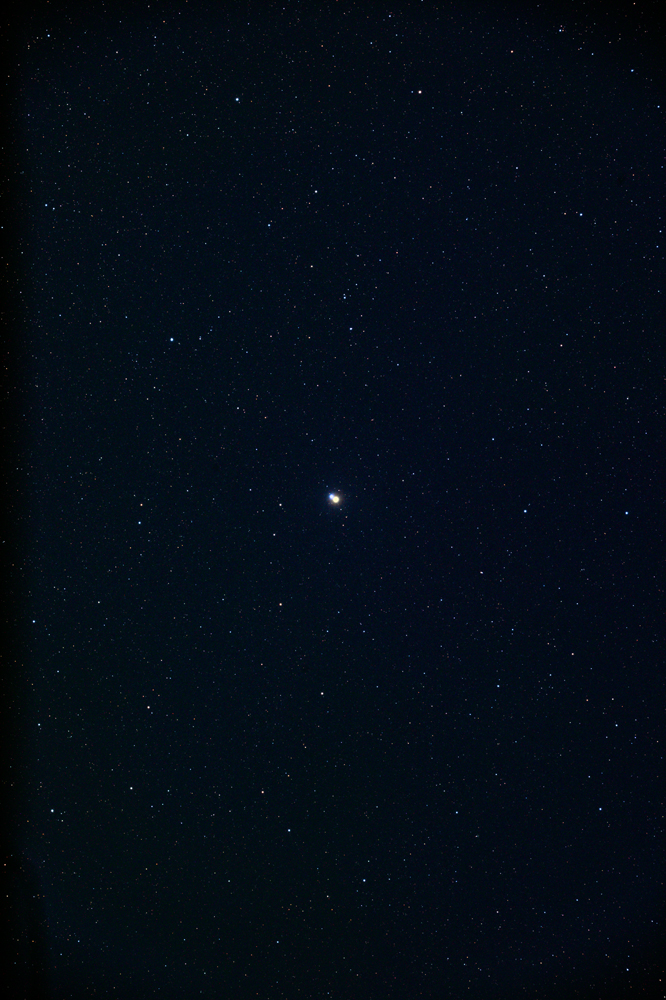

|
Werner E. Celnik
Rheinberg (Germany) |
150mm |
|

|
|
|
|
STF2594, 57 Aql |
|
AB |
5m.7 |
6m.3 |
36.3" |
171° |
2019 |
Aql |
19h54m37.65s / -08°13'38.30" |
René Merting
Drachhausen (Germany) |
10x50 |
ein einfacher Doppelstern - schön getrennt - Komponente A strahlt etwas weißer |
|
René Merting
Drachhausen (Germany) |
16x70 |
ein ansehnliches gut getrenntes Sternpaar - Komponente B im Süden ist gut eine halbe Größenklasse schwächer - das Weiß von Komponente A wirkt etwas kühler, während B eher in einem wärmeren zarten creme-gelb strahlt |
|
René Merting
Drachhausen (Germany) |
100mm (20x) |
bei 32x ein sehr auffälliges, komfortabel getrenntes Sternpaar - Komponente B im Süden ist eine halbe Magnitude schwächer - zurück auf 20x immernoch eine ordentliche Trennung, B wirkt jetzt etwas schmutziger weiß |
|
Sarah Gebauer
Germany |
100mm (21x) |
02.10.23: bei 21-fach ein gut getrenntes, helles, weißes Pärchen, die nördliche Komponente strahlt etwas warmweißer, die südliche etwas kaltweißer - bei 49-fach ändert sich zumindest am Farbeindruck nichts - schön mit im Bild ist weiter südlich der roségoldene 56 Aql |
|
Uwe Pilz
Leipzig (Germany) |
105mm (22x) |
orange-blau |
|
Uwe Pilz
Leipzig (Germany) |
320mm (36x) |
|

|
René Merting
Drachhausen (Germany) |
320mm (45x) |
der DS ist bei 45x schon sehr gut getrennt zu sehen, A ist leicht gelblich, B blauweiß, ein schönes Farbkontrastpaar mit weitem Abstand und etwa einer dreiviertel Größenklasse Helligkeitsunterschied |
|
|
Berthold Fuchs
Wiesbaden (Germany) |
130mm |
easy DS |

|
|
|
★★★
|
STFA50, 30/31 Cyg, omicron Cyg |
|
AC |
3m.9 |
7m.0 |
108.6" |
173° |
2016 |
Cyg |
20h13m37.90s / +46°44'28.80" |
|
|
|
|
AD |
3m.9 |
4m.8 |
336.7" |
322° |
2016 |
|
|
Robert Zebahl
Leipzig (Germany) |
naked eye |
AD: Well split with noticeable difference in brightness. |
|
René Merting
Drachhausen (Germany) |
naked eye |
meist sehe ich nur einen diffusen Lichtpunkt und dann irgendwann … immer wieder sind A und D klar erkennbar und getrennt voneinander zu sehen - D steht in Richtung Nordwesten von A aus gesehen |
|
Sarah Gebauer
Germany |
naked eye |
AC: 16.09.23 Jeßnigk: Ohne zu wissen, dass es möglich ist, lässt sich Omicron 1 Cygni in beide Komponenten auftrennen - mit deutlichem Helligkeitsunterschied und sichtbarem Abstand zueinander sind beide Sterne sehr gut einzeln zu sehen |
|
Christopher Hay
Seeheim (Germany) |
3x63 |
AD: Self-built binoculars, hence the unusual specification.
Widely split, A (31 Cyg) light orange, D (30 Cyg) light blue. |
|
Christopher Hay
Seeheim (Germany) |
7x50 |
A-D: Widely split, A (31 Cyg) luminous orange-red, D (30 Cyg) luminous ice-blue. C set off from A as a fine speck of light. |
|
Robert Zebahl
Leipzig (Germany) |
8x40 |
AC: Observation at full moon. Easily split with big difference in brightness. Brighter component slightly orange. C component rather faint. |
|
Robert Zebahl
Leipzig (Germany) |
8x40 |
AD: Wonderful double star for binoculars. Large distance of the components, brighter once (31 Cyg) appeared slightly orange, the fainter (Cyg 30) more bluish. |
|
Christopher Hay
Seeheim (Germany) |
15x45 |
A-D: Very wide apart but still perceived as belonging together. A (31 Cyg) orange-red, D (30 Cyg) ice-blue. C well set off from A and light ice-blue, like an echo of D. A delightful group of three for binoculars at this power, further accentuated by nearby orange Omicron2 Cygni. Both the brightnesses and colour hues of Omi1A and Omi2 appear practically identical. |
|
Robert Zebahl
Leipzig (Germany) |
16x70 |
2020-07-03: Fantastic sight. A: bright orange, D: white-bluish, C: light blue. Very beautiful field. |
|
René Merting
Drachhausen (Germany) |
18x70 |
wunderschön - Komponente A präsentiert sich buttergelb - die südliche, schwächste Komponente C zeigt sich aquamarinblau - D im Norden ist reinweiß und steht dreimal weitere entfernt wie AC |
|
René Merting
Drachhausen (Germany) |
76mm (57x) |
Mondscheinnacht - bei 29x ein wunderschönes Sterntrio, A wirkt goldgelb, D weiß mit einem Stich ins türkise, C ist kühlweiß mit einem Stich ins Blaue |

|
Robert Zebahl
Leipzig (Germany) |
80mm (25x) |
AC: Similar to the observation with binoculars. C component appeared bluish and gave good contrast to the orange colored 31 Cyg. |
|
René Merting
Drachhausen (Germany) |
100mm (32x) |
bei 32x sind alle drei Sterne weit getrennt und doch irgendwie zusammengehörend, Komponente A ist rapsgelb und am auffälligsten, Komponente D strahlt weiß und die schwächste Komponente C schimmert bläulich, schöner Anblick |
|
Robert Zebahl
Leipzig (Germany) |
102mm (28x) |
Bright, wide apart and wonderful contrast in color. A: light yellowish-orange, C: blue, D: light blue. |

|
René Merting
Drachhausen (Germany) |
107mm (30x) |
|

|
Sarah Gebauer
Germany |
150mm (30x) |
die drei Komponenten plus Omicron2 bilden ein wunderschönes, sehr langes und spitzes Dreieck und zeigen dabei wundervolle Farben, Komponente A von o1 sowie o2 erscheinen schön gelblich, Komponente D von o1 hat einen deutlichen Blaustich im Weißen, wirklich ein sehr schönes Gesamtbild - auf Komponente C hatte ich nicht geachtet |

|
Sarah Gebauer
Germany |
150mm (85x) |
dieses Mal nur die drei dicht beieinanderstehenden Komponenten A, C und D im Sichtfeld gehabt, Komponente A ist wieder deutlich gelbgold, C wirkt leicht bläulich und Komponente D wirkt dieses Mal eher weiß |

|
|
|
★★★
|
BLL49, U Cyg |
|
|
8m.0 |
9m.0 |
65.4" |
231° |
2015 |
Cyg |
20h19m41.66s / +47°54'19.90" |
|
|
Robert Zebahl
Leipzig (Germany) |
16x70 |
2020-07-03: Easy split with very good color contrast: white and clear orange. |
|
Sarah Gebauer
Germany |
100mm (80x) |
20.09.23: absolut vergleichbar mit der Beobachtung mit dem 10''-Spiegel, alle Sterne wirken nur etwas schwächer, der Farbeindruck ist jedoch genau so intensiv |

|
Robert Zebahl
Leipzig (Germany) |
102mm (28x) |
2019-08-22: While the primary component appears quite unspectacular in a white, the companion U Cygni is much more interesting. It is a carbon star whose brightness varies between 5m9 and 12m1 with a period of about 463 days. It appears in mostly intensely orange, and even deep red in the towards its minimum. Extremely rewarding! |
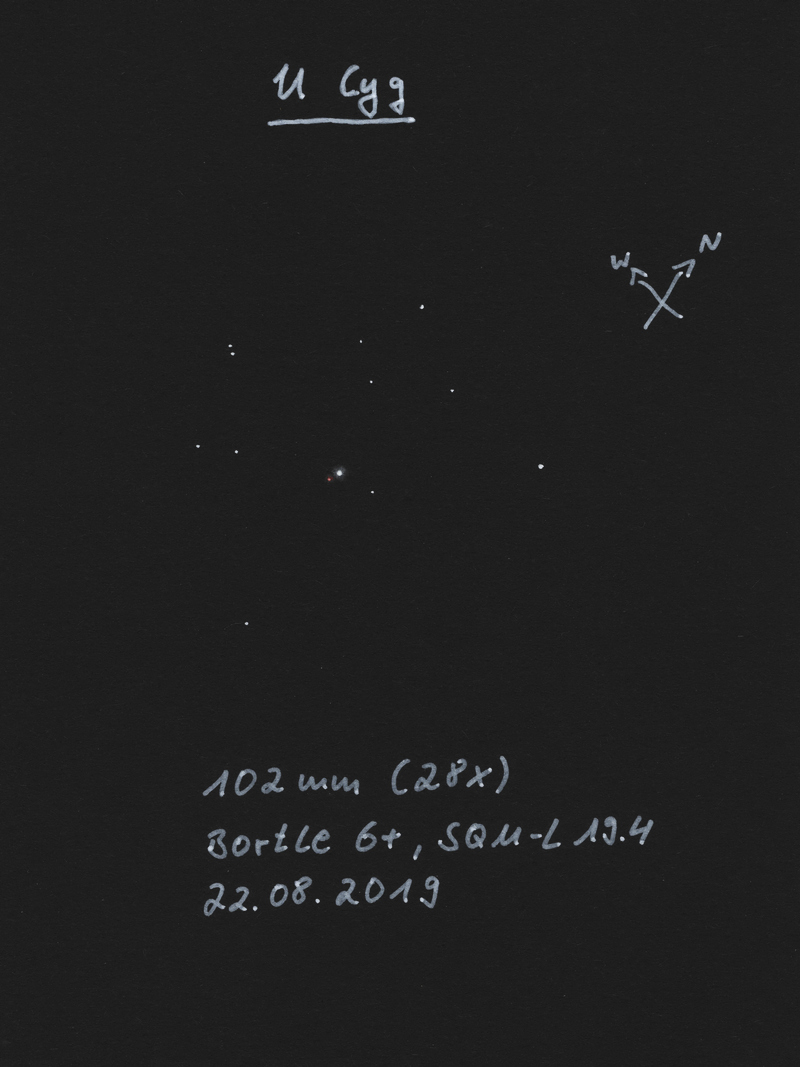
|
Sarah Gebauer
Germany |
254mm (96x) |
12.09.23: abartig krebsrot, richtig metallisch, dunkel, stark und ein richtiger Kracher bei 96-fach - der Begleiter im Nordosten mit recht weitem Abstand zeigt ein ganz zartes, hellbuttriges Cremegelb |

|
René Merting
Drachhausen (Germany) |
320mm (72x) |
|

|
|
|
|
STFA52, beta Cap, beta 1/2 Cap, 9 Cap, Dabih |
|
AB |
3m.1 |
6m.1 |
205.2" |
266° |
2016 |
Cap |
20h21m00.67s / -14°46'53.00" |
|
|
|
|
AC |
3m.1 |
8m.8 |
226.1" |
133° |
2012 |
|
|
|
|
|
|
BC |
6m.1 |
8m.8 |
396.5" |
111° |
2015 |
|
|
René Merting
Drachhausen (Germany) |
12x50 |
AB: beide Sterne sind halb so weit getrennt, wie die Komponenten von Alpha Cap (STFA 51), Abstand aber immernoch riesig - B ist deutlich schwächer, schätzungsweise 2.5 Magnituden - B wirkt grau gegen die leicht gelb schimmernde A-Komponente |
|
René Merting
Drachhausen (Germany) |
15x56 |
AB: ein auffälliges Paar, wenn auch weit auseinanderstehend - A im Osten strahlt glänzend gelblich, B dagegen ist weißgrau und mindestens 2 Größenklassen schwächer |
|
Sarah Gebauer
Germany |
254mm (49x) |
AB: bei 49-fach ist bei der Hauptkomponente auf ein Anhieb ein sehr warmgelber bis kupfergoldener Farbton zu sehen – bei 96-fach mischt sich ein weißer Glanz dazu – der Begleiter steht weit abseits und zeigt bei 49-fach einen sehr kühlen Farbton |
|
René Merting
Drachhausen (Germany) |
320mm (45x) |
AB: ?1 und ?2 Capricorni - A strahlt bei 45x sehr schön gelb, etwas weniger imposant als Alpha Cap, die B-Komponente steht weit getrennt westlich und strahlt eher weiß-grau und 2-3 Größenklassen schwächer
A-DE: nordwestlich von A sind die beiden Komponenten DE bei 45x nochmals als eine ganz schwache Komponente in einem rechten Winkel zu A und B zu sehen, der Helligkeitsunterschied zu B beträgt nochmals etwa 2-3 Größenklassen |
|
|
|
★★
|
STF2727, 12 Del, gamma Del |
|
AB |
4m.4 |
5m.0 |
8.8" |
266° |
2020 |
Del |
20h46m39.50s / +16°07'27.40" |
|
|
Christopher Hay
Seeheim (Germany) |
8x42 |
On tripod. Definite elongation, and eastern end of elongation (i.e. component A) is definitely brighter than the other end. PA estimated at 240° without prior knowledge. |
|
Christopher Hay
Seeheim (Germany) |
15x45 |
Stabilised binoculars, handheld. A very elongated figure-8 very close to popping apart. According to Stelledoppie a physical double with a period of 3249 years. Observed in June 2019 when separation was 8,89“. Will be 8.67“ in 2030 according to Stelledoppie. |
|
Robert Zebahl
Leipzig (Germany) |
16x70 |
2021-09-02: Beautiful sight in very nice surrounding. Easy to split, but quite small separation. A rather small difference in brightness is clearly visible. The primary component appears golden in color. |
|
Christopher Hay
Seeheim (Germany) |
18x80 |
Very tight pair but clearly split with black in-between. Observed in July 2019 when separation was 8,89“. An excellent object to test the resolution of large binoculars. Struve 2725 a few arcminutes to the southwest is a further good test object for magnifications >20x. |
|
Christopher Hay
Seeheim (Germany) |
40x80 |
Widely split, visually strong, dominating the field of view. Component A appears yellowish compared to component B. Struve 2725 in same FOV finely split. |
|
René Merting
Drachhausen (Germany) |
100mm (32x) |
bei 32x knapp getrennt - Komponente A ist schön gelb, B im Westen ist gut 1.5 Magnituden schwächer (lt. Stelle Doppie Helligkeitsunterschied nur 0.67 mag) - zusammen mit dem wesentlich schwächeren STF2725 gut 15' südlich sehenswert |
|
Sarah Gebauer
Germany |
100mm (45x) |
bei 45x sauber getrennt und zusammen mit dem DS STF 2725 in einem Gesichtsfeld, dadurch wirken sie wie ein optisches Doppel-Doppel, sehr schön! Beide DS bilden auch einen auffälligen Lichthof |

|
Sarah Gebauer
Germany |
100mm (80x) |
01.10.23: bei 80-fach zeigt sich der DS sehr hell, gut getrennt und strahlend maisgelb - schön zusammen mit dem südwestlich stehenden Doppelstern STF 2725, der ebenfalls leicht Farbe zeigt |

|
Uwe Pilz
Leipzig (Germany) |
105mm (66x) |
im selben Feld mit STF2725 |
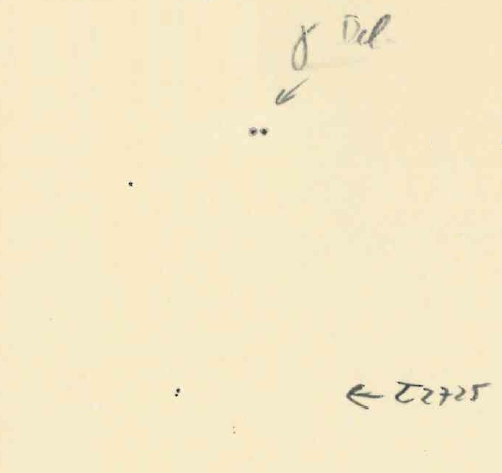
|
Uwe Pilz
Leipzig (Germany) |
105mm (144x) |
schon trennbar bei 26x. In einem Feld mit STF2725 |

|
René Merting
Drachhausen (Germany) |
107mm (60x) |
bei 30x getrennt, bei 60x kommen die Farben aber noch schöner zur Geltung, A ährengelb bis biergelb, B im Westen ist rinr Größenklasse schwächer und samtig hellgelb, schöner Farbkontrast |

|
Robert Zebahl
Leipzig (Germany) |
152mm (30x) |
2021-09-11: Difference in brightness well visible. Light yellow/golden & lemon yellow. |
|
Mark McCarthy
Fremont (California/USA) |
152mm (175x) |
Gam2 Del. Gorgeous, light yellow-orange A and blue-green B, I like this better than Albireo. Physical with 3249-year period, it will slowly tighten the next couple of hundred years |
|
Mark McCarthy
Fremont (California/USA) |
152mm (285x) |
Gam 2 Del. ! Most beautiful light orange-yellow A and ~1 delta mag blue-green B |
|
Mark McCarthy
Fremont (California/USA) |
317mm (277x) |
Gamma Delphinus. Rich gold-yellow A, blue-white B, ~6" separation estimated by eye. Very pretty pair. |
|
Karsten Kopp
Köln (Germany) |
600mm (180x) |
Recht heller und auch leicht zu trennender Doppelstern mit ca. 0,5 mag Helligkeitsunterschied. Komponente A leuchtet schön gelblich und Komponente B weiß. |
|
|
|
★
|
STF2806, 8 Cep, beta Cep, Alfirk |
|
AB |
3m.2 |
8m.6 |
13.6" |
250° |
2020 |
Cep |
21h28m39.58s / +70°33'38.50" |
Sarah Gebauer
Germany |
100mm (45x) |
bei 45x haarscharf getrennt, die zweite Komponente fällt erst auf den zweiten Blick auf, da sie viel schwächer und kleiner ist und beinahe vom Lichtschein der Hauptkomponente überstrahlt wird |

|
Sarah Gebauer
Germany |
100mm (49x) |
01.10.23: der DS ist bei 21-fach nur ein greller, weißer Stern - bei 49-fach zeigt sich plötzlich ein bedeutend schwächerer, schmutzig grauer Begleitstern im Westsüdwesten, A strahlt nach wie vor alpina-reinweiß |
|
Mark McCarthy
Fremont (California/USA) |
152mm (175x) |
Alfirk. Bright yellow-green and 3 delta mag, bluish b, wide. WDS uncertain, no Gaia data on the primary |
|
|
Frederik Wanink
Itterbeck (Germany) |
254mm |
|

|
|
|
★★
|
STF2841 |
|
A-BC |
6m.5 |
8m.0 |
22.4" |
110° |
2018 |
Peg |
21h54m17.44s / +19°43'05.30" |
Robert Zebahl
Leipzig (Germany) |
70mm (22x) |
At 22x easy to separate with considerable difference in brightness. The primary component appeared slightly yellowish-orange, the fainter component greyish-blue. The slight color contrast was especially visible at 44x. |
|
Sarah Gebauer
Germany |
100mm (49x) |
01.10.23: ein ganz klassisches Farbkontrastpaar von Gelbgold zu Leinblütenblau, bei 49-fach schön getrennt |

|
Uwe Pilz
Leipzig (Germany) |
105mm (88x) |
|

|
Mark McCarthy
Fremont (California/USA) |
203mm (533x) |
Very wide 2 delta mag pair, white and light blue [COU 432 is the AB, 0.1" near equal, was 0.2" at discovery!] |
|
Mark McCarthy
Fremont (California/USA) |
317mm (553x) |
Orange & blue, very wide separation, ~2 magnitude difference. |
|
|
Berthold Fuchs
Wiesbaden (Germany) |
130mm |
easy DS |

|
|
|
★★
|
STF2893 |
|
|
6m.2 |
7m.9 |
28.9" |
347° |
2018 |
Cep |
22h12m52.76s / +73°18'25.90" |
Sarah Gebauer
Germany |
100mm (45x) |
ein deutlicher und sehr schöner Farbkontrast der beiden ähnlich hellen Komponenten, gelblich-orange und bläulich trifft es sehr gut, die Farben sind recht stark und der DS erinnert an einen Mini-Albireo |

|
Mark McCarthy
Fremont (California/USA) |
152mm (175x) |
Light orange A and light blue 3 delta mag., very wide. A feels like it's a snowman (no other companion to A). WDS says physical, which is unusual for a wide separation, but it does share 23% parallax range overlap, 6,332 AU weighted separation but pretty high solar mass 3.74/2.03 |
|
|
|
★★
|
delta Cep, 27 Cep |
BU702 |
AB |
4m.2 |
13m.0 |
21.5" |
282° |
2015 |
Cep |
22h29m10.25s / +58°24'54.70" |
|
|
|
STFA58 |
AC |
4m.2 |
6m.1 |
41.0" |
191° |
2018 |
|
|
|
|
|
DAL45 |
AD |
4m.2 |
13m.9 |
109.0" |
39° |
2015 |
|
|
|
|
|
DAL45 |
DE |
13m.9 |
14m.0 |
1.4" |
23° |
2008 |
|
|
Christopher Hay
Seeheim (Germany) |
7x45 |
AC: Hand tremor hampers splitting A and C at this low magnification, as the apparent separation is small. Nonetheless, a grey-blue C dances next to the luminous-orange A.
Component A is the prototype of the Cepheid class of variable stars, with a brightness variation of a full magnitude over 5 days. To assess a somewhat difficult handheld binocular split like this it would really be necessary to know the momentary brightness of A, but I didn’t have a telescope at hand. |
|
René Merting
Drachhausen (Germany) |
15x56 |
AC: ein wunderschönes Paar - A strahlt satt gelb, C zeigt sich gut getrennt und tendiert mehr ins weißgraue - dadurch ein schöner Farbkontrast |
|
Robert Zebahl
Leipzig (Germany) |
16x70 |
AC: 2020-09-20: Nice separation with noticeable difference in brightness. Slightly yellowish & white-bluish. |
|
Robert Zebahl
Leipzig (Germany) |
55mm (27x) |
AC: At 27x easy to separate, rather wide apart with clear difference in brightness. At 38x the colors are slightly better visible: A shines in bright orange, C appears rather grey-bluish. |
|
Robert Zebahl
Leipzig (Germany) |
80mm (25x) |
AC: Obvious difference in brightness and color. Brighter component slightly orange, weaker bluish. Could be Albireo's little brother ;) |
|
René Merting
Drachhausen (Germany) |
107mm (30x) |
AC: bei 30x ein sehr auffälliges Sternpaar mit einem auffälligen Farbkontrast - auch wenn C deutlich schwächer ist, so strahlen doch beide Sterne um die Wette - Komponente A zeigt sich Siennagelb, C wirkt Blauweiß - ordentliche Trennung - bei 6x ändert C ein wenig seine Farbe, ich habe mitunter den Eindruck, Grünblau zu sehen |
|
Sarah Gebauer
Germany |
150mm (85x) |
AC: die hellere Komponente ist sehr intensiv und richtig schön goldgelb und die zweite, deutlich schwächere Komponente hat einen sichtbar bläulichen Farbstich, insgesamt schon ab 21x sehr schön anzuschauen |

|
Mark McCarthy
Fremont (California/USA) |
508mm (667x) |
DE: Slight brightening in the diffraction ring |
|
|
Frederik Wanink
Itterbeck (Germany) |
254mm |
AC |
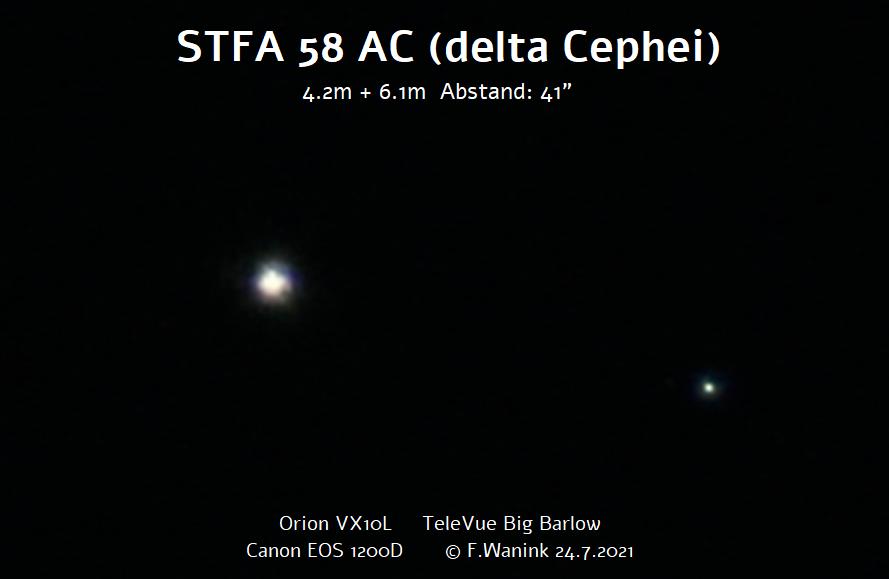
|
|
















